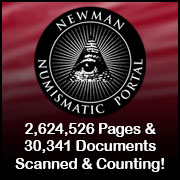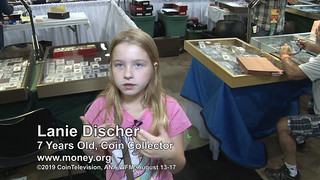
About UsThe Numismatic Bibliomania Society is a non-profit association devoted to the study and enjoyment of numismatic literature. For more information please see our web site at coinbooks.org SubscriptionsThose wishing to become new E-Sylum subscribers (or wishing to Unsubscribe) can go to the following web page link MembershipThere is a membership application available on the web site Membership Application To join, print the application and return it with your check to the address printed on the application. Print/Digital membership is $40 to addresses in the U.S., and $60 elsewhere. A digital-only membership is available for $25. For those without web access, write to: Charles Heck, Treasurer
AsylumFor Asylum mailing address changes and other membership questions, contact Chuck at this email address: treasurer@coinbooks.org SubmissionsTo submit items for publication in The E-Sylum, write to the Editor at this address: whomren@gmail.com BUY THE BOOK BEFORE THE COINSale Calendar |
- WAYNE'S WORDS: THE E-SYLUM JANUARY 12, 2020
- KOLBE & FANNING SALE 155 ANNOUNCED
- NEW BOOK: TOKENS: CULTURES, CONNECTIONS, COMMUNITIES
- NEW BOOK: 1912 BRETON REPRINT
- NEW BOOK: NUMISMATICA ESPANOLA 1474 -2020
- REVIEW: DU SIMITIÈRE AND HIS MUSEUM
- BOOK REVIEW: OLD MANILA, 2ND EDITION
- NEWMAN PORTAL ADDS CLAM SHELL MONEY RESEARCH
- VIDEO: YOUNG NUMISMATIST LANIE DISCHER
- THE USE OF MEDALS IN ADVERTISING
- BANKERS ASSOCIATION CLAD COINAGE BROCHURE
- NOTES FROM E-SYLUM READERS: JANUARY 12, 2020
- WHERE'S GEORGE THESE DAYS?
- VOCABULARY TERMS: HIGHLIGHT, HIGHLIGHTING
- SAMUEL BELKNAP (1751-1821)
- HOGE ON 'BRITAIN IN AMERICA' AT BNS MEETING
- QUERY: EMERY MAY NORWEB PHOTO SOUGHT
- SELECTIONS FROM DAVISSON'S E-AUCTION 34
- SELECTIONS FROM ROBINSON SALE 111
- RESTRICTIVE TURKEY, TUNISIA AGREEMENTS, PART 2
- GOLD BAR WAS LOOTED AZTEC TREASURE
- THE CZECH TOWN THAT INVENTED THE DOLLAR
- SYMBOLS ON AMERICAN MONEY: THE EAGLE
- STACK’S BOWERS OFFERS 1884 AND 1885 TRADE DOLLARS
- MORE ON THE BURKE & HERBERT BANK VAULT
- LADY GODIVA AND THE TOKENS OF COVENTRY
- MICROMOSAIC COINS: GIRL WITH A PEARL EARRING
- ENGLAND’S FIRST RECORDED STATE LOTTERY
- LOOSE CHANGE: JANUARY 12, 2020
- BATHROOM FLOOR TILED WITH PENNIES
Click here to access the complete archive
Click here to unsubscribe (scroll down)
To comment or submit articles, reply to whomren@gmail.com
Content presented in The E-Sylum is not necessarily researched or independently fact-checked, and views expressed do not necessarily represent those of the Numismatic Bibliomania Society.
WAYNE'S WORDS: THE E-SYLUM JANUARY 12, 2020
 New subscribers this week include: Henry Parker of the Southern Idaho Coin Club, courtesy of John Mutch. Welcome aboard! We now have 6,070 subscribers.
New subscribers this week include: Henry Parker of the Southern Idaho Coin Club, courtesy of John Mutch. Welcome aboard! We now have 6,070 subscribers.
Thank you for reading The E-Sylum. If you enjoy it, please send me the email addresses of friends you think may enjoy it as well and I'll send them a subscription (but let me know if they are located in the European Union). Contact me at whomren@gmail.com anytime regarding your subscription, or questions, comments or suggestions about our content.
NBS Members: It's that time of year again - please renew your membership by check or online with Paypal. For more information, see:
https://www.coinbooks.org/about/
membership.html
This week we open with a new sale from Kolbe & Fanning, three new books, two reviews, updates from the Newman Numismatic Portal and notes from E-Sylum readers.
Other topics this week include medals as product advertising, clad coinage, Where's George?, collectors Samuel Belknap and Emery May Norweb, selections from the upcoming Davisson and Robinson sales, Aztec treasure, and the 1884 and 1885 Trade Dollars.
To learn more about the early coins of Russia, the first American national museum, California clam shell money, the Franklin Mint in Canada, glass coin weights, hotel coin washing, the birthplace of the dollar, micromosaic coins, Bert & Ernie, Caps of the Dioscuri, the Spithead Mutiny of 1797, Lady Godiva, and the Girl with a Pearl Earring, read on. Have a great week, everyone!
Wayne Homren
Editor, The E-Sylum
KOLBE & FANNING SALE 155 ANNOUNCED
Kolbe & Fanning's next numismatic literature sale will close February 1, 2020. Here's the announcement. -Editor
KOLBE & FANNING ANNOUNCE FEBRUARY 1 BOOK AUCTION
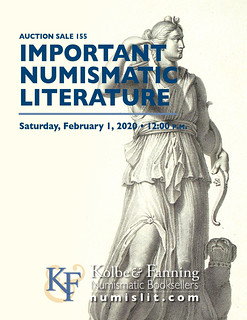 Kolbe & Fanning Numismatic Booksellers are announcing our Sale 155, which will be held on Saturday, February 1, 2020. The 426-lot sale includes a wide-ranging
selection of books on ancient, world and U.S. numismatics, including material from the libraries of Bob Vail, Jeff Peck, Doug Robins and Phil Carrigan. The sale features
particularly notable American auction catalogues, along with key references on ancient and world coins, many of them rarely encountered.
Kolbe & Fanning Numismatic Booksellers are announcing our Sale 155, which will be held on Saturday, February 1, 2020. The 426-lot sale includes a wide-ranging
selection of books on ancient, world and U.S. numismatics, including material from the libraries of Bob Vail, Jeff Peck, Doug Robins and Phil Carrigan. The sale features
particularly notable American auction catalogues, along with key references on ancient and world coins, many of them rarely encountered.
Some highlights of the sale include:
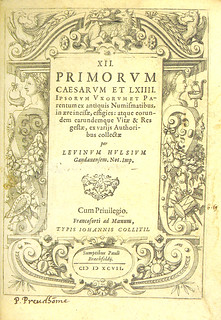
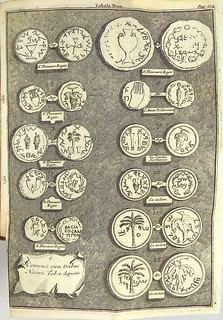
Lot 74: a well-preserved copy of Hulsius’s 1597 work on the Caesars and their families, featuring 75 fine engravings of Roman portrait coins
Lot 110: Nicola Haym’s copy of Adriaan Reland’s rare 1709 volume on Jewish and Islamic coins, De Nummis Veterum Hebraeorum
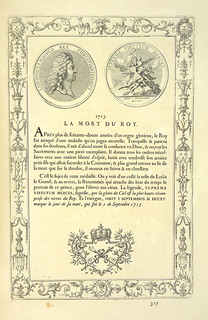
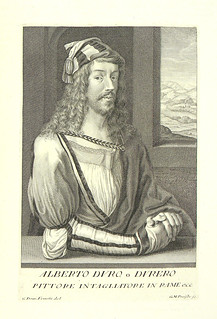
Lot 140: the 1723 second edition of the extraordinary compendium on the medals of Louis XIV, expanded from the 1702 edition to include the entirety of the monarch’s reign
Lot 185: three volumes of the impressive Museum Florentinum series on portraits and painting (1752–1756), with exceptional engraved plates; the sale also includes (as lot 51) the Museum Florentinum volume on ancient statuary
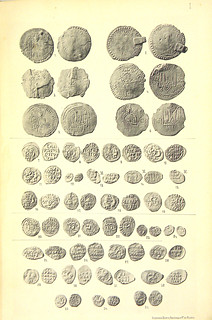
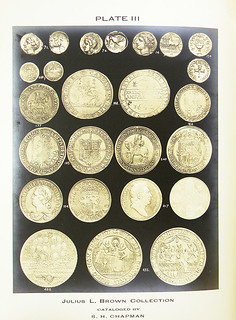
Lot 191: a very good copy of Aleksei Oreshnikov’s well-illustrated 1896 masterwork on the early coins of Russia, Russkiya monety do 1547 goda
Lot 278: Lester Merkin’s plated copy of S.H. Chapman’s 1911 Julius Brown sale, featuring fine ancient, English and European coins, pioneer gold, and choice United States silver and copper coins
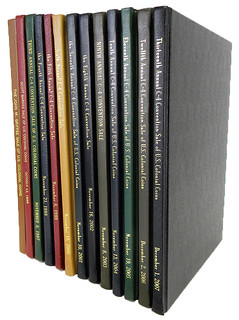
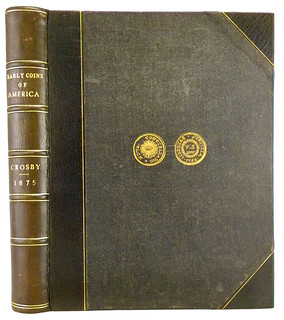
Lot 285: Neil Rothschild’s set of thirteen hardcover auction catalogues from conventions of the Colonial Coin Collectors Club (C4)
Lot 286: a very attractive original copy of Crosby’s 1875 Early Coins of America in a Nova Constellatio binding
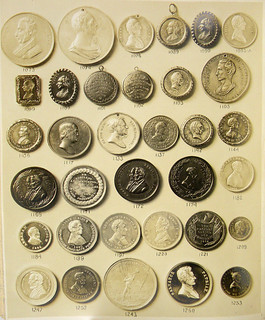
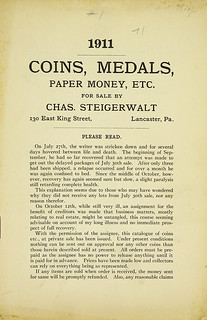
Lot 297: Tom Elder’s 1918 McCoy, Brown & Ezekiel sale, with eight superb photographic plates, a landmark sale of American political tokens that is also important for large cents
Lot 403: an exceptional collection of 99 different fixed price lists issued by Charles Steigerwalt, of Lancaster, Pennsylvania, between 1885 and 1911; also included in the sale (as lot 402) is a substantial collection of 48 of Steigerwalt’s auction catalogues.
Bids may be placed via post, email, fax or phone, as well as online. Kolbe & Fanning use Auction Mobility as our third-party online bidding platform. Auction Mobility is an app-based platform allowing users the ability to participate in the sale through phones, tablets and computers. To register for the sale, bidders must go to bid.numislit.com and sign up. Once you have set up an account, you may browse lots, place advance bids, or participate in the live sale online. Those wishing to participate on their devices can download the Kolbe & Fanning app through the Apple or Google Play Store.
The printed catalogue of Sale 155 was mailed to active customers this week. A PDF of the printed catalogue has been posted to our main website at numislit.com for those who prefer that format. Bids placed via post, email, fax or phone must be received by January 31, the day before the sale, in order for them to be processed. Advance absentee bids may also be placed at any time online at bid.numislit.com; live internet bidding will be available during the sale itself through the same platform.
Kolbe & Fanning Numismatic Booksellers LLC is a licensed and bonded auction firm in the State of Ohio. For more information, please see the Kolbe & Fanning website at numislit.com or email David Fanning at df@numislit.com. To register for the sale, go to bid.numislit.com. We look forward to your participation.

NEW BOOK: TOKENS: CULTURES, CONNECTIONS, COMMUNITIES
The Royal Numismatic Society has published a new book on tokens from ancient to modern times. It's being offered by Spink. -Editor
 Tokens: Cultures, Connections, Communities
Tokens: Cultures, Connections, Communities
A Crisà, M Gkikaki and C Rowan (editors)
Hardback, jacketed
210 x 298mm
248pp
RRP: £40
ISBN: 0 901405 35 3
This volume is the first dedicated to the analysis of tokens ranging from the Neolithic until the modern age. The volume discusses tokens from different periods in detail, addressing the makers, users, types and contexts of these objects. Unpublished material is presented in several of the contributions. This comparative approach reveals the recurring characteristics of tokens across time, as well as their importance to human society.
Contents:
- Introduction by Antonino Crisa, Mairi Gkikaki & Clare Rowan
- The Invention of Tokens by Denise Schmandt-Besserat
- Some Notes on Athenian Bronze Tokens and Bronze Coinage in the Fifth and
- Fourth Centuries BC by Kenneth A. Sheedy
- Tokens Inside and Outside Excavation Contexts: Seeking the Origin.
- Examples of Clay Tokens from the Collections of the Athens Numismatic Museum by Stamatoula Makrypodi
- The Armour Tokens from the Athenian Agora by Martin Schafer
- A Rare Clay Token in Context: A Fortunate and Recorded Discovery from the Necropolis of Tindari (Messina, 1896) by Antonino Crisa
- Roman tesserae with Numerals: Some Thoughts on Iconography and Purpose by Alexa Kuter
- Lead Token Moulds from Rome and Ostia by Clare Rowan
- Tokens of Antinous from the Roman Province of Egypt by Denise Wilding
- Tokens in the Athenian Agora in the Third Century AD: Advertising Prestige and Civic Identity in Roman Athens by Mairi Gkikaki
- Using and Reusing Tokens: Some Remarks About Christian Graffiti on Contorniates by Cristian Mondello
- The Holme Cultram Abbey Series: English Medieval Tokens and a Cistercian Use Case by Kate Rennicks
- How Royal Tokens Constituted an Art Medium that Participated in the Monarchical System Between 1610 and 1661 by Sabrina Valin
- For Change and Charity: Identifying the Motivations and Characteristics of Issuers of Tokens in the British Isles in the Mid-Seventeenth Century by Laura Burnett
- 'Success to the Seventeen United Bright Stars': The Spithead Mutiny of 1797 Recorded on a Sailor's Love Token by Bridget Millmore
- The Politics of Token Economics, Then and Now by Bill Maurer
- Index
For more information, or to order, see:
New Titles RNS SP57 - Tokens: Cultures, Connections, Communities
(https://spinkbooks.com/index.php?route=product/product&path=59/&product_id=705)

NEW BOOK: 1912 BRETON REPRINT
I've only just this week come across this (it was published in 2018), but a reprint of the 1912 Breton guide to Canadian coins, tokens and medals is available on the Trajan Media coin and stamp supply web site. -Editor
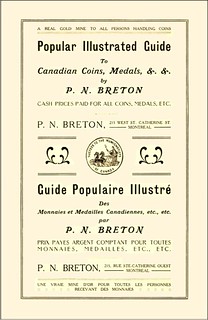 1912 Breton Reprint – 2018 Edition
1912 Breton Reprint – 2018 Edition
$55.95
This book is 268 pages in size, and contains the following:
• All of the over 1000 obverse and reverse engravings of coins and tokens found in P.N. Breton’s 1894 guide.
• All of the 198 original pages of this guide have been reproduced, with 70 pages added for pricing and for a Breton Number look-up index.
• The Breton numbering system used by collectors and dealers for referencing pre 20 thcentury Canadian coins.
• 400 engravings of 207 different medals.
• The prices paid for coins, tokens and medals in 1912.
• A section describing Courteau Numbers 251 to 319 for coins and tokens of Nova Scotia.
• Pricing for Breton coins and tokens taken from the 7th Edition of the Professional Edition Price Guide for Canadian Coins by Brookstone Publishing, arranged in ascending by order of Breton Numbers.
• An index to assist with matching a Breton Number to a Breton Token
For more information, or to order, see:
1912 Breton Reprint – 2018 Edition
(https://coinstampsupplies.com/product/1912-breton-reprint-2018-edition/)
NEW BOOK: NUMISMATICA ESPANOLA 1474 -2020
Éditions V. Gadoury is offering as new book on Spanish coins, but there is little information on their web site. Here's the cover and some sample pages. -Editor
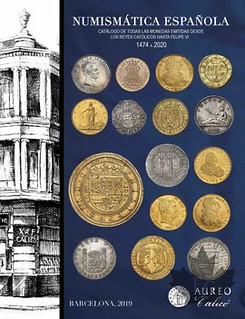
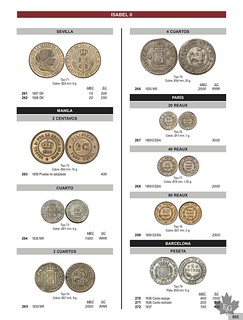
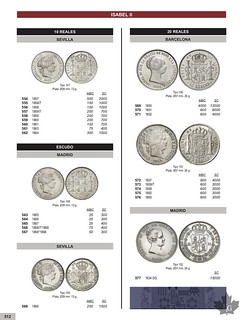
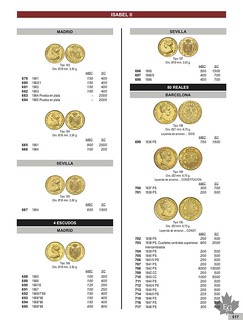
For more information, or to order, see:
NUMISMATICA ESPANOLA 1474 -2020 (https://www.gadoury.com/en/books/numismatica-espanola-1474-2020)
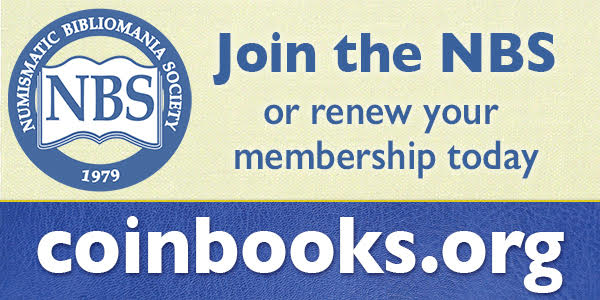
REVIEW: DU SIMITIèRE AND HIS MUSEUM
Joel Orosz provided this review of a recently published paper by Gian Domenico Iachini of the State University of Milan on Pierre Eugene Du Simitière and the First American National Museum. Thanks! Many thanks also to Paul Bosco of New York for bringing this new study to our attention. The paper references Joel's great 1988 book The Eagle that is Forgotten: Pierre Eugène Du Simitière, Founding Father of American Numismatics. -Editor
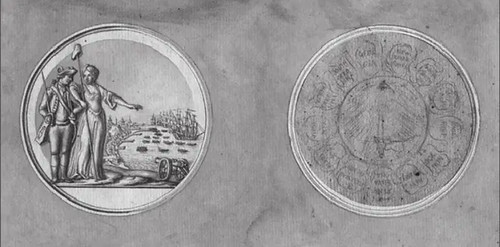
Pierre Eugene Du Simitière, George Washington Before Boston, obverse and reverse, designs for medal, 1776, The Library Company of Philadelphia
The paper itself is solidly researched and well-written. He did miss my work on Du Simitiere in my dissertation, Curators and Culture: The Museum Movement in America, 1740-1870, published by the University of Alabama in 1990, but I won't hold that against him, since I treated more than a dozen representative museums during that time span. A key word search would not turn up the fact that part of it was about Du Simitiere.
Most of the Du Simitiere material Iachini covers, especially regarding numismatics, has been presented before, principally by Hans Huth, Paul Sifton, and me. Iachini does bring out some new (at least to me) material on Du Simitierie's work on state seals, which is useful. I was able to follow Du Simitiere's numismatic collection to his co-executor, Ebenezer Hazard, but John Lupia has taken if further, tracing it to another sale in Philadelphia in 1813--but after that, the trail turns cold.
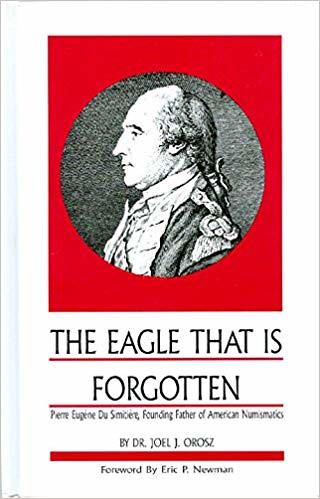 My only substantive criticism of the numismatic portion of the paper, regards the statement Iachini makes on p. 142: "His knowledge and his remarkable collection make him
the first numismatist of the New World." Du Simitiere was not even the first numismatist in North America--Rev. William Bentley was collecting coins and medals in the 1760s,
and writing about them by 1765. Samuel Curwen and Rev. Andrew Elliot were in the field at about the same time as Bentley.. I'm not aware of specific numismatists in the French
and Spanish colonies of the new world, but given the traditions of the mother countries, and in the Spanish colonies particularly, the vast numbers of coins being produced, I
would be astonished if there weren't isolated numismatists collecting and writing long before Du Simitiere stepped onto the soil of the new world.
My only substantive criticism of the numismatic portion of the paper, regards the statement Iachini makes on p. 142: "His knowledge and his remarkable collection make him
the first numismatist of the New World." Du Simitiere was not even the first numismatist in North America--Rev. William Bentley was collecting coins and medals in the 1760s,
and writing about them by 1765. Samuel Curwen and Rev. Andrew Elliot were in the field at about the same time as Bentley.. I'm not aware of specific numismatists in the French
and Spanish colonies of the new world, but given the traditions of the mother countries, and in the Spanish colonies particularly, the vast numbers of coins being produced, I
would be astonished if there weren't isolated numismatists collecting and writing long before Du Simitiere stepped onto the soil of the new world.
On balance, though, Iachini's work is well-done, and since The Eagle That is Forgotten has been well-nigh forgotten during the 30 years since it was published, it certainly couldn't hurt to revisit this topic in The E-Sylum. Reading his work may well inspire new interests in or at least appreciation of, the early days of numismatic interest in what has become the United States.
To read the complete paper, see:
Pierre Eugene Du Simitière and the First American National
Museum (https://www.academia.edu/14254305/Pierre_Eugene
_Du_Simiti%C3%A8re_and_the_First_American_National_Museum)
Here's an excerpt summarizing Du Simitière and his impact. -Editor
Having arrived in the New World as a young painter, illustrator, and translator, and having spent many years researching and collecting, DuSimitière decided to follow the old European custom of setting up a “Curio Cabinet” containing relics of many types, and gradually to expand his collection until it became “greatly celebrated in America, where it is unrivalled,” according to the Marquis de Chastellux who saw it in 1782 (Chastellux 111). Years before its opening to the general public, however, his studio was frequented by travelers and men of politics, such as Continental Congress member Richard Smith who reported in his diary in 1775 that he had amused himself “all the morning in Du Simitière’s museum”
When Du Simitière officially opened his sundry collection of Americana to the public in 1782, the exhibition was essentially arranged in “natural” and “artificial” curiosities that spanned from specimens and sketches of natural history to modern and antique artifacts. He did not mention (or, if so, probably summarized) his known numismatic collection as well as his trove of printed materials concerning the history of the Colonies and the American Revolution as “a number of miscellaneous Curiosities of various kinds.”
Though short-lived and its founder forgotten soon after his death and burial in an unmarked grave in St. Peter’s Church Yard in Philadelphia, Du Simitière’s American Museum predates by three years the one traditionally credited as the first of the republic, founded by the well-known painter Charles Willson Peale in the same city.
A scholar, a voracious collector of books and “curiosities,” and the acquaintance of three future presidents of the United States and other major political and military leaders of the time, Du Simitière himself was a “very curious man,” as John Adams described him in an oft-quoted letter to his wife; the epithet “curious” is le mot juste for a man single-handedly able (and always with limited economic resources) to put together one of the best libraries on the continent and its first historical museum.
Bibliophiles will appreciate Du Simitière's eye for collecting ephemera. -Editor
In New York, during 1769 and 1770, he became a naturalized citizen and deepened his interest in the colonies’ growing controversy with London, beginning his custom of picking up from the street broadsides, pamphlets, handbills, and newspapers related to the politics of the day. The percentage of the now unique printed items that he gathered together is staggeringly high; these documents illuminate the revolutionary era as only informal productions of a period can.
Thankfully, Du Simitière and his monumental contributions to the study of American history and numismatics are not quite forgotten, thanks to the writings of Orosz, Iachini and others. I encourage our readers to acquaint themselves with his life and work through these excellent, well-illustrated studies. -Editor
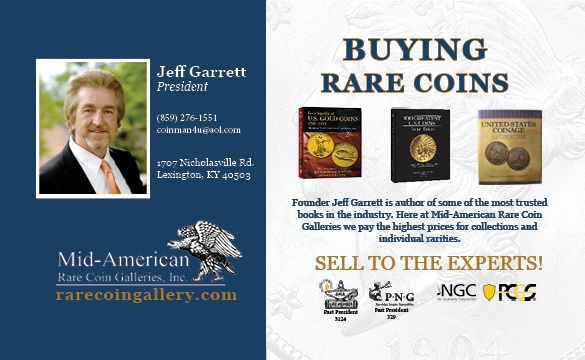
BOOK REVIEW: OLD MANILA, 2ND EDITION
A review published in The Philippine Star notes a a chapter in a 2016 book that examines the entire history of currency in Manila. -Editor
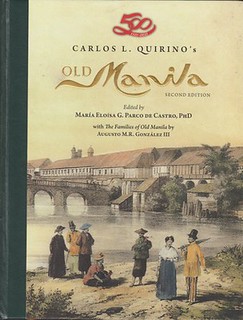 This is a beautiful book. This is the first time I have ever used that adjective to describe a book. Old Manila 2nd Edition by Carlos L. Quirino is edited by
Maria de Castro as the second edition to the original book Maps and Views of Old Manila by Quirino which was published in 1971 to celebrate the 400th anniversary of the
City of Manila.
This is a beautiful book. This is the first time I have ever used that adjective to describe a book. Old Manila 2nd Edition by Carlos L. Quirino is edited by
Maria de Castro as the second edition to the original book Maps and Views of Old Manila by Quirino which was published in 1971 to celebrate the 400th anniversary of the
City of Manila.
There are 18 essays in the book.
The fifth essay is “Making a Living in Ancient and Spanish Manila.” It traced the evolution of this city from subsistence farming to hacienda crops and finally to being an Asian maritime center with the advent of the galleon trade. It also traces the evolution of currency from barter trading to dependence on the Mexican silver coin to the first Philippine minted coins beginning 1861.
To read the complete article, see:
Memories of Old Manila
(https://www.philstar.com/opinion/2020/01/12/1984044/memories-old-manila)
For more information, see:
Old Manila (https://www.goodreads.com/book/show/36425659-old-manila)
NEWMAN PORTAL ADDS CLAM SHELL MONEY RESEARCH
The latest addition to the Newman Numismatic Portal is a new research paper on California clam shell money. Project Coordinator Len Augsburger provided the following report. -Editor
Newman Portal Adds Research Paper on California Clam Shell Money
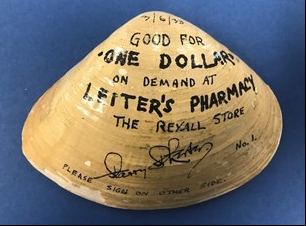 Recently added to Newman Paper is a paper by Joshua Smith, “The California Clam Shell Scrip Currency of 1933: Crescent City and Pismo Beach’s anomaly in an era of
Banknote Scrip.” Supported by a Newman Grant from the Eric P. Newman Numismatic Education Society, Smith conducted primary research on this curious scrip that arose in California
during the Great Depression.
Recently added to Newman Paper is a paper by Joshua Smith, “The California Clam Shell Scrip Currency of 1933: Crescent City and Pismo Beach’s anomaly in an era of
Banknote Scrip.” Supported by a Newman Grant from the Eric P. Newman Numismatic Education Society, Smith conducted primary research on this curious scrip that arose in California
during the Great Depression.
Smith explores the origins of the use of clam shells as money and describes modern reproductions in order to aid authentication of genuine examples. Certain questions in numismatics are eternal – how was an object made, who made it, how was it used – and Smith provides an end-to-end treatment of the subject.
Image: Example of clam shell money issued by Leiter’s Pharmacy in 1933 (Pismo Beach City Hall collection).
Link to “The California Clam Shell Scrip Currency of 1933” on Newman Portal:
https://nnp.wustl.edu/library/book/573710
VIDEO: YOUNG NUMISMATIST LANIE DISCHER
These are selections from the David Lisot Video Library that feature news and personalities from the world of coin collecting. David has been attending coin conventions since
1972 and began videotaping in 1985. The Newman Numismatic Portal now lists all David’s videos on their website at:
https://nnp.wustl.edu/library/multimediadetail/522852
Here's one interviewing young numismatist Lanie Discher. -Editor
An excerpt of the video is available for viewing on the Coin Television YouTube Channel at:
https://youtu.be/NL8V5Z407Eo
Lanie & Andy Discher, David Lisot, Interviewer, CoinTelevision.com.
Parents are so important to get kids started collecting coins. A father brings a young daughter to the American Numismatic Association who is already a coin collector.
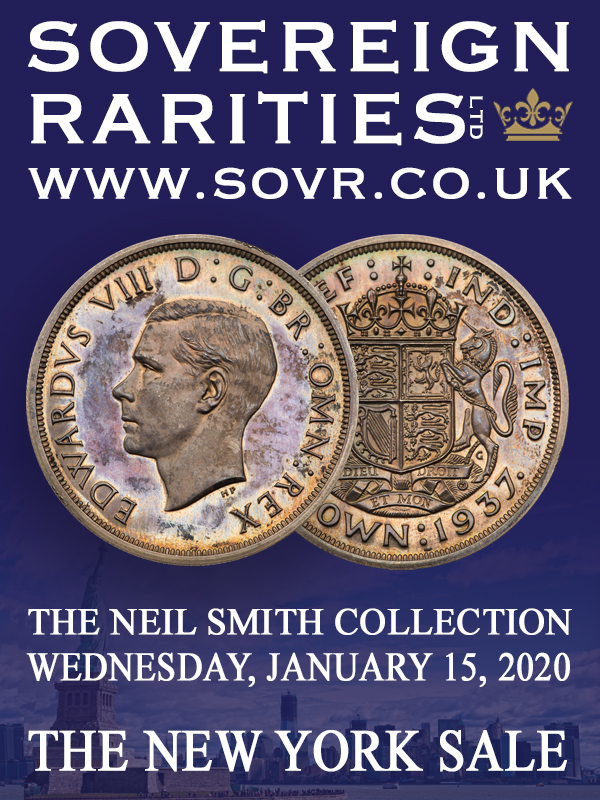
THE USE OF MEDALS IN ADVERTISING
Ken Traub wrote the original article on the 1902 Paris in London Exhibition medal discussed in earlier issues. I passed along to him (via Nick Graver) Jenna Moore Fuller's question about it last week. Here's his response. -Editor
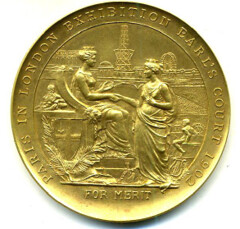 I had received no further information from the medal dealers and experts I contacted nor from anyone else since I wrote my article in 2012, nor have I seen any other
medals on the market. I have been a subscriber to The E-Sylum for years, and I can’t believe I missed the two follow-up comments on my medal. Now at least know that some
other private collection has a silver version of my gold medal.
I had received no further information from the medal dealers and experts I contacted nor from anyone else since I wrote my article in 2012, nor have I seen any other
medals on the market. I have been a subscriber to The E-Sylum for years, and I can’t believe I missed the two follow-up comments on my medal. Now at least know that some
other private collection has a silver version of my gold medal.
I’ve also admired advertising use of medals awarded to companies. My favorite of the ones I’ve seen is the McCann’s Steel Cut Oat Meal, which is still sold and a tin of which currently resides in my pantry. It’s delicious by the way, and is still made and available in this tin can! https://www.amazon.com/McCANNS-Steel-Irish-Oatmeal-28-Ounce/dp/B001EO5U3I
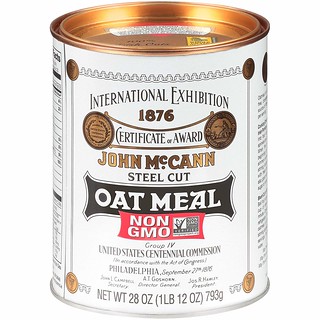 It has likenesses of the award medals the company won at the 1851 London Exhibition at the famed Crystal Palace, the U.S. Centennial Exhibition of 1876 in Philadelphia,
and the 1893 Colombian Exposition in Chicago. I’m happy to say that I own an example of each of the medals illustrated on the can.
It has likenesses of the award medals the company won at the 1851 London Exhibition at the famed Crystal Palace, the U.S. Centennial Exhibition of 1876 in Philadelphia,
and the 1893 Colombian Exposition in Chicago. I’m happy to say that I own an example of each of the medals illustrated on the can.
Thank you Wayne, Nick, and Jenna for this chance to remind me what knowledge and fun one can derive from the pursuit of numismatics and exonumia!
Other readers have noticed this type of medal usage as well.
Paul Horner writes:
This is a (flattened) box of spaghetti with a gold medal from the 1893 Columbian Exposition. I haven't seen a spaghetti Medal before! From Dollar Tree: $1 for a pound and a half of award winning pasta. My favorite brand!
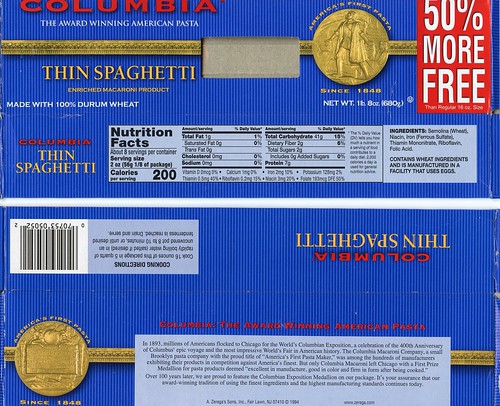
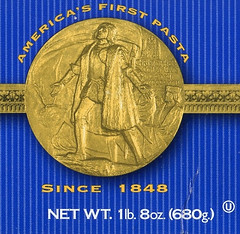
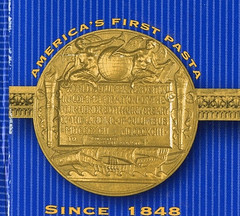
So your product won a medal two centuries back? Wow, impressive...
To read the earlier E-Sylum article, see:
1902 PARIS IN LONDON EXHIBITION MEDAL AWARDEE (https://www.coinbooks.org/v23/esylum_v23n01a14.html)
THE BOOK BAZARRE
BANKERS ASSOCIATION CLAD COINAGE BROCHURE
Dave Lange writes: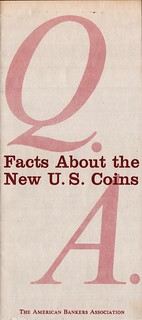 I came across this brochure that I acquired years ago and had just tucked away. It was put out by the American Bankers Association in 1965 to prepare the public for the
new clad coinage.
I came across this brochure that I acquired years ago and had just tucked away. It was put out by the American Bankers Association in 1965 to prepare the public for the
new clad coinage.
Like nearly all publications addressing the changeover it tries to assure readers that the silver coins will not go up in value enough to justify saving them and that the hoarding of silver coins will not be cost-effective. Both the government and the banking industry stuck to the script by proclaiming that the older coins would circulate alongside the new pieces for many years to come. I recall from my own collecting experience that silver became increasingly scarce during 1966-67, and it disappeared nearly overnight after the period for redeeming silver certificates ended in mid-1968. These were my formative years in the hobby, and it was quite discouraging to have even the common coins from the 1950s-60s vanish.
Thanks! Nice piece of numismatic ephemera. It's a tortured piece of blatant propaganda. Their explanation of Gresham's Law is laughable and their answer to "Will Gresham's law hamper our new coinage system?" is (of course) "no".
I was eight years old in 1966, and I remember my grandmother showing me a new clad coin and telling me about the changeover from silver. A few years later I started a paper route and kept all the silver coins that came my way. -Editor

NOTES FROM E-SYLUM READERS: JANUARY 12, 2020
The Franklin Mint in Canada
John Regitko writes:
The Franklin Mint also operated in Canada.
When I took over the chairmanship of the Coin Exhibit at the Canadian National Exhibition (CNE) in 1976, I had the CNE carpenters build new show cases and displays as is shown in the center of the photo. I also asked The Franklin Mint's Canadian operation to set up an exhibit, which they readily agreed to because of the promotional value.
From my point of view, it filled up space and displayed some wonderful looking "numismatic" items... even though I had hesitations at the time in exposing the down side of numismatics to the general public that came to the Arts Crafts Hobbies building to view the Coin Exhibit. I was given the second largest square footage (square meters in Canada, square metres in England). Understandably, only the model train exhibit had more space to show off their locomotives and trains running around hundreds of feet of railway tracks through the mock hilly countryside complete with trees, bridges, railway stations and little people.
The Franklin Mint display is at the right in the old black & white photo. The actually display looked a lot better than the photo shows.
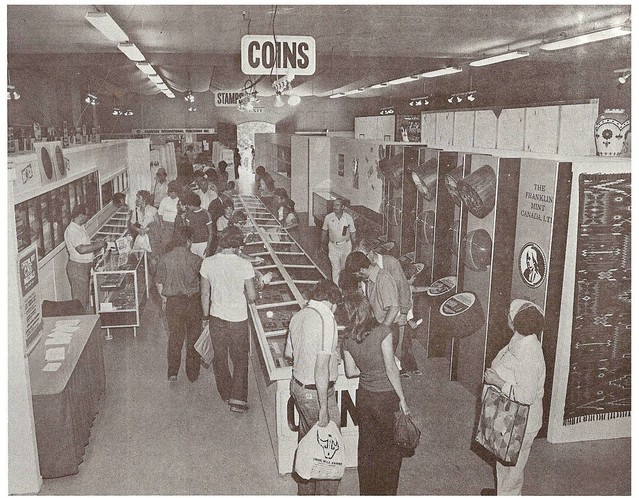
Thanks. Nice exhibit, Perhaps someone will write a history of the company someday. -Editor
To read the earlier E-Sylum article, see:
MORE ON JOSEPH SEGEL AND THE FRANKLIN MINT (https://www.coinbooks.org/v23/esylum_v23n01a11.html)
Canada's Counterfeit Cop Camaraderie
John Regitko also submitted this interesting background on another exhibit at the show which got some unwanted attention. Thanks! -Editor
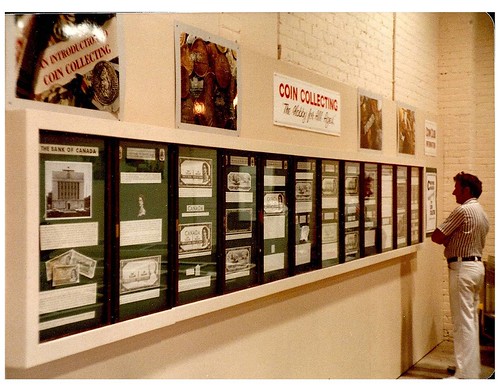
Incidentally, the display that was most commented on was the one I created on how Canada's paper money was printed by the banknote companies. I am attaching photos of the wall display. The comments evolved around the fact that the copying of paper money was a criminal offence at the time, subject to summary conviction. There was no such thing as less than half or more than double the actual size. I got around that by visiting the Corporal in charge of the Counterfeit Division for the RCMP in Toronto, who sent me to the Toronto Police who shared responsibility for counterfeiting in the Toronto area, who sent me to the Attorney General's office at Queen's Park (where the Government of Ontario hangs out). Each one pulled out the Criminal Code of Canada and gave me a scolding for creating the display before I contacted them (I told them I did it first "in case you might not allow me to do it").
They agreed not to arrest me, so I displayed it in the hopes they did not change their mind. Good thing they were aware of it, because when a Toronto Star newspaper reporter saw the same display at a coin convention, he called the Toronto Police who paid me a visit on a Friday. Because they were aware of the exhibit, they asked when I could take it down. I answered that as chairman, I am quite busy. "How about Sunday at 5:00 p.m.?" I asked. In a very stern voice, one of the two detectives looked me straight in the eyes and said? "Okay, but not a minute later!" He then smiled and left.
The display that helped earn the Coin Exhibit one of the two three exhibitor awards (they did not rate them in order, but I was told that the CNE judges places us second).
I wrote a two-part article in Canadian Coin News.
There are hundreds of short stories like this that are either entertaining, education or just interesting. One of your many subscribers should solicit input and publish a book on collectors' and dealers' submissions.
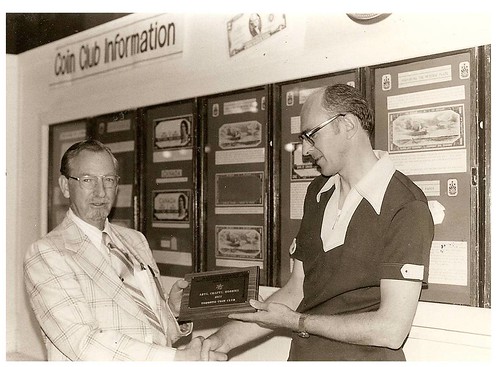
Fred Brown and John Regitko
On Declaring Your Cash When Leaving the Country
Ken Berger writes:
In the last E-Sylum there was mention of a couple who were caught leaving the country with $19,651 in cash. I did not see how they violated any laws, other than not declaring the full amount (which they could have done). Since there were two of them and each person is allowed a $10,000 limit, they did not exceed $20,000.
Anyway, I went to the appropriate gov't website & it stated "Please be aware, if persons/family members traveling together have more than $10,000, they cannot divide the currency between each other to avoid declaring the currency." So, if you are traveling together and use one custom declaration form, the $10K includes everybody. I didn't know that, did you?
However, it doesn't say what happens if each person fills out their own declaration form.
Interesting nuance. -Editor
To read the earlier E-Sylum article, see:
LOOSE CHANGE: JANUARY 5, 2020 : Cash-Sniffer Catches Casablanca-Bound Couple
(https://www.coinbooks.org/v23/esylum_v23n01a29.html)
Glass Coin Weights
Roger Moore writes:
The article on a new book, The Coin-Weights of Ireland, by Paul & Bente Withers jarred my memory of an exhibit I saw at the Corning Glass Museum last year. Evidently coin-weights were also made from glass since this was an ideal material due to being inexpensive to make, non-deteriorating with exposure to the elements, and hard to tamper with without such tampering being obvious to anyone critically examining them. I have attached a photo from the exhibit of six coin-weights that were used in the 8th to 10th century. When I saw the exhibit I was startled to learn that glass was used but on further thought I can see how this was a logical material.
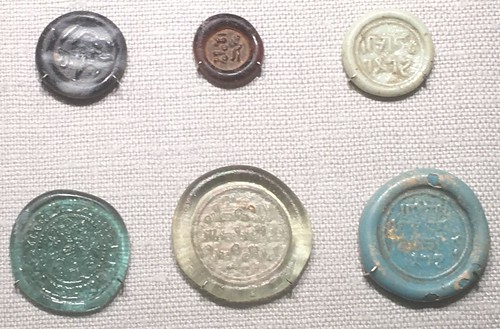
Thanks! -Editor
To read the earlier E-Sylum article, see:
NEW BOOK: THE COIN-WEIGHTS OF IRELAND (https://www.coinbooks.org/v23/esylum_v23n01a05.html)
Hotel Coin Washing
Bruce H. Smith writes:
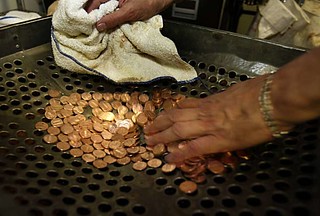 I have a different take on the piece about currency being washed in a S. American bank. Sometime in the 60s I heard that the Mark Hopkins Hotel in San Francisco machine
washed all of the coins used by the hotel, and I believe that the tale came from a Dennis the Menace comic book. To test my memory, I contacted the Mark Hopkins by email. I had a
reply from the Chief Concierge. He related that the Westin St. Francis was known for washing their coins, although he didn't discount the idea that it may have happened at the
Mark Hopkins too. The Westin St. Francis said that the washing continued until the last decade.
I have a different take on the piece about currency being washed in a S. American bank. Sometime in the 60s I heard that the Mark Hopkins Hotel in San Francisco machine
washed all of the coins used by the hotel, and I believe that the tale came from a Dennis the Menace comic book. To test my memory, I contacted the Mark Hopkins by email. I had a
reply from the Chief Concierge. He related that the Westin St. Francis was known for washing their coins, although he didn't discount the idea that it may have happened at the
Mark Hopkins too. The Westin St. Francis said that the washing continued until the last decade.
My correspondent says that the practice stemmed, in part, from a desire to help keep the white gloves of female guests clean. I wonder if other hotels of the era also washed their coins.
After typing this I had the thought that when I had originally searched for possible confirmation, I had typed in Mark Hopkins. Searching without the hotel name gave up a number of stories about the St. Francis.
Bruce passed along this 2010 article about the Westin St. Francis coin washers. Thanks! We've touched on the topic before - see the linked articles from 2011. -Editor
To read the complete article, see:
Coin washer keeps Westin St. Francis' change shiny
(https://www.sfgate.com/bayarea/article/Coin-washer-keeps-Westin-St-Francis-change-shiny-2518445.php)
To read the earlier E-Sylum articles, see:
ARTICLE HIGHLIGHTS SAN FRANCISCO HOTEL'S MONEY LAUNDERER (https://www.coinbooks.org/esylum_v14n36a17.html)
NOTES FROM E-SYLUM READERS: SEPTEMBER 4, 2011 : Coin Laundering at the St. Francis Hotel
(https://www.coinbooks.org/esylum_v14n37a20.html)
NOTES FROM E-SYLUM READERS: DECEMBER 22, 2019 : Money Laundering, Literally
(https://www.coinbooks.org/v22/esylum_v22n51a10.html)
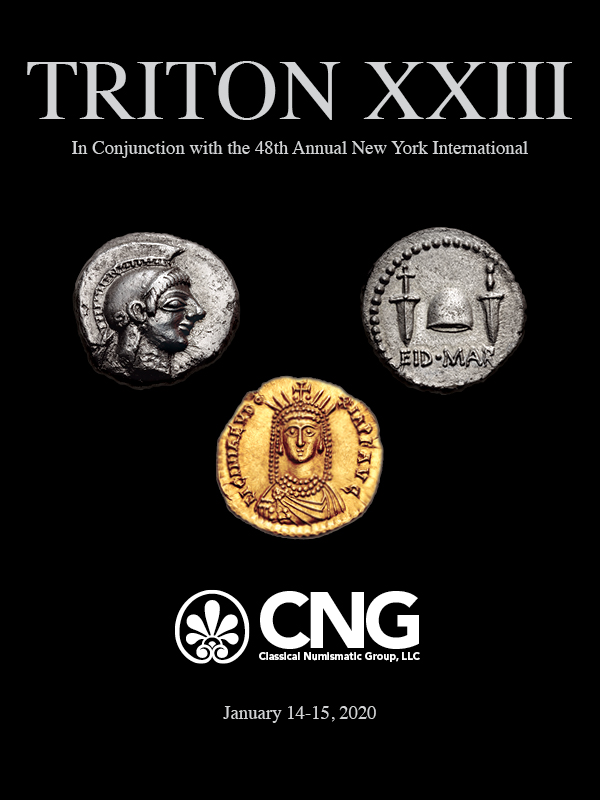
WHERE'S GEORGE THESE DAYS?
John Lupia found this "Where's George" overstamped dollar in change recently. -Editor
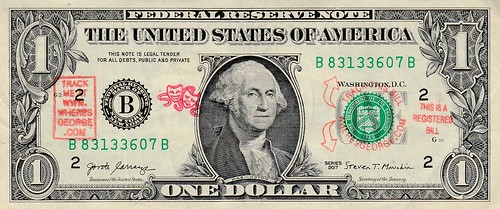
I haven't come across any of these in a while and hadn't visited the site in some time. There's a lot there to see, including user forums and all sorts of reports based on the data. There is a store selling the Where's George stamps, and there is quite a variety available now - several dozen in all, with each available in different colors as well. The store would make a good basis for a catalog of the different types of overstamps, although it may not be comprehensive. -Editor
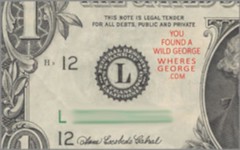
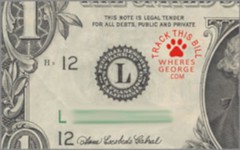
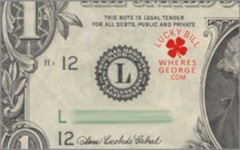
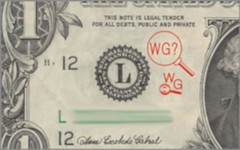
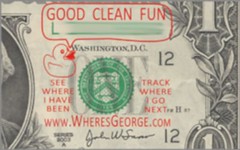
To visit the Where's George site, see:
https://www.wheresgeorge.com/
To read earlier E-Sylum articles, see:
BY GEORGE, WHERE'S GEORGE? AND THOMAS? (https://www.coinbooks.org/esylum_v13n36a13.html)
SO THAT'S WHERE GEORGE IS: FORT LAUDERDALE, FL (https://www.coinbooks.org/esylum_v13n47a25.html)
NPR EXAMINES THE SCIENCE OF 'WHERE'S GEORGE?' (https://www.coinbooks.org/esylum_v16n13a18.html)

VOCABULARY TERMS: HIGHLIGHT, HIGHLIGHTING
Dick Johnson submitted this entry from his Encyclopedia of Coin and Medal Terminology. Thanks. -Editor
Highlight, Highlighting. Creating a contrast of light and dark areas on a metal surface. Highlighting a medallic item puts dark coloring in crevices and some low areas of the relief, and, by burnishing or buffing, making the higher areas lighter in color. The relief stands out because of this two-toned effect, the contrast aids the human eye in perceiving the total view. Highlight is the result of oxidation (actually a sulphatization) and this relieving.
Most patina finishes will employ some form of highlighting and this is a major function of the finishing department. There is no highlighting in coin finish, as coins and tokens receive no finish after they are struck; for most medallic work, however, it is the next important step after the medals are fully struck, trimmed and edgemarked.
How medals are highlighted. Medallic items come to the finishing department in tote boxes, they are fully struck up and edgelettered – all the steps of the pressroom are complete including trimming and any edge treatment. The medal at this stage is called a raw medal. The first step is an abrasive blasting with very fine abrasive particles, as sand or glass beads; this gives the raw medal surface a "tooth" to accept further finishing treatment, particularly with fluids. Actually these microscopic pits are called cups to retain the liquid.
The abrasive is grossly removed, by shaking off all loose particles, the medals are then placed into wire baskets and doused into a darkening solution (as ammonium sulfate). Immersion time is critical, being removed quickly after the desired darkness has occurred, the medals are then thoroughly washed to stop the darkening action by immersion in still water or running water or both. This washing also removes any residual abrasive particles.
At this stage the medals are totally black or as dark as desired – one color. They are brought to a workbench where a wet wheel is located. A medal is covered with a pumice slurry and buffed on the wet wheel to remove the dark toning on the high points, on flat surfaces and all areas coming in contact with the buffing wheel. The dark color remains in the crevices and near some relief where it outlines and thusly emphasizes or highlights the relief. This forms the two-toned effect.
Afterwards the medals are washed of all pumice and dried; at this point they are even baked to remove all possible moisture, then lacquered. Some highlight action may continue under the lacquer; such residual toning can be observed in about six month's time and continues, possibly, for several years.
See finish and finishing.
Looking for the meaning of a numismatic word, or the description of a term? Try the Newman Numismatic Portal's Numismatic Dictionary at: https://nnp.wustl.edu/library/dictionary
Or if you would like a printed copy of the complete Encyclopedia, it is available. There are 1,854 terms, on 678 pages, in The Encyclopedia of Coin and Medal Technology. Even running two a week would require more than 19 years to publish them all. If you would like an advance draft of this vital reference work it may be obtained from the author for your check of $50 sent postpaid. Dick Johnson, 139 Thompson Drive, Torrington, CT 06790.

SAMUEL BELKNAP (1751-1821)
Samuel Belknap (1751-1821), was born on May 28, 1751, son of Jeremiah Belknap (1686-1751), and Mary Rand Belknap, at Boston, Massachusetts.
He is listed in the 1789 Boston Directory working as a goldsmith and jeweler at his shop located at 30 Cornhill, Boston, Massachusetts.
He donated several coins and Continental paper money to the cabinet of the Massachusetts Historical Society (MHS) reported by his elder half brother Rev. Jeremy Belnap (1744-1798), Founder of the Society and Corresponding Secretary on August 3, 1796 in the local newspaper, the Columbian Centinel. The report says he donated an English coin of Queen Elizabeth, a 10 shilling note of New Hampshire dated 1737, a 10 shilling note of Massachusetts dated 1742, and a key to the French Fort of Annapolis taken in 1710.
Belknap's donation gives us a window to the numismatic collecting culture in the late eighteenth century providing evidence that historical Continental paper money was already collected and conserved as collectible heirlooms of early Americana for a cabinet.
He died June 20, 1821 at Boston, Massachusetts. He is buried at Granary Burying Ground.
Massachusetts coinage minted John Hull is also interred at the Granary Burying Ground. -Editor
To read the complete article, see:
BELKNAP, SAMUEL
(https://sites.google.com/a/numismaticmall.com/www/numismaticmall-com/belknap-samuel)
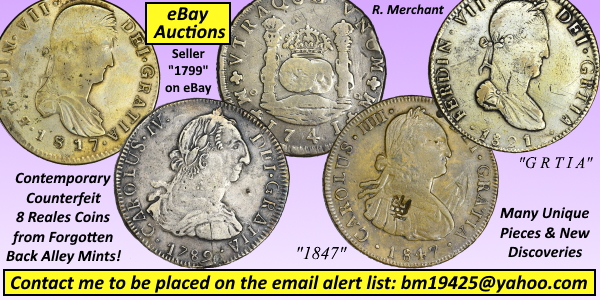
HOGE ON 'BRITAIN IN AMERICA' AT BNS MEETING
British Numismatic Society Secretary Peter Preston-Morley submitted this announcement of the group's annual meeting at NYINC show in New York City this week. -Editor
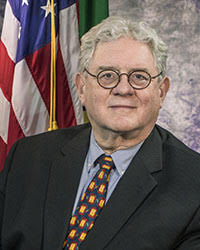 The meeting will take place in the Uris Room at the Grand Hyatt Hotel on E 42nd Street, on Saturday January 18th, at 4 PM.
The meeting will take place in the Uris Room at the Grand Hyatt Hotel on E 42nd Street, on Saturday January 18th, at 4 PM.
Our speaker is Robert Hoge, Curator Emeritus at the American Numismatic Society. Robert’s subject will be: Britain in America: a survey of the American Numismatic Society cabinet.
The American Numismatic Society (ANS) collections of British coins are comprehensive in scope, but vary greatly in representativeness and depth. Since its founding in 1858 the cabinet has depended almost exclusively for the development of its holdings upon the generosity of individual benefactors. Consequently, it reflects the many differences among their interests, specialisations and potential level of acquisitions. This paper will look at the content and origins of the British coins in the collection and demonstrate that the Society sought to build a representative sample of British coinage, medals, tokens and paper money while avoiding competing with the British Museum and other long established major collections.
All are welcome, and you don’t have to be a member of the Society to attend.
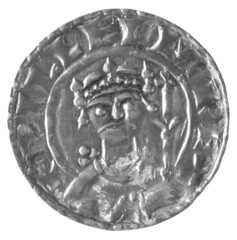
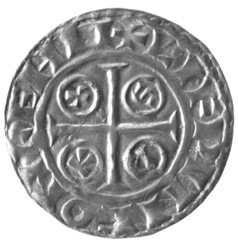
A penny of William the Conqueror, of the PAXS type, from the mint of Chester by the moneyer Lifwine, is ANS Accession no. 1974.34.18. It was a gift of the famous collector Mrs. Emery May (Holden) Norweb, wife of Ambassador R. Henry Norweb -- both of whom were important benefactors.
For more information on the British Numismatic Society, see:
https://www.britnumsoc.org/

QUERY: EMERY MAY NORWEB PHOTO SOUGHT
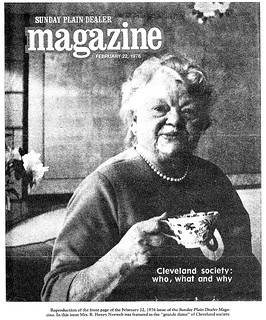 Dave Bowers located this black and white microfilmed image of Cleveland collector Emery May Norweb from the February 22, 1976 Sunday Plain Dealer Magazine. He
would like to get a color image, but the newspaper and libraries don't seem to have one. Would anyone have this original publication, or know where a color photo could be
obtained?
Dave Bowers located this black and white microfilmed image of Cleveland collector Emery May Norweb from the February 22, 1976 Sunday Plain Dealer Magazine. He
would like to get a color image, but the newspaper and libraries don't seem to have one. Would anyone have this original publication, or know where a color photo could be
obtained?
Here's an excerpt of her entry in Pete Smith's American Numismatic Biographies on the Newman Numismatic Portal. -Editor
Date of Birth: 1896 - Nov - 30
Date of Death: 1984 - Mar - 27
Born in Salt Lake City, Nevada; granddaughter of Liberty Emery Holden, founder of the Cleveland Plain Dealer. Daughter of Albert Fairchild Holden. She married R. Henry Norweb in Paris in 1917. She drove an ambulance and worked in French hospitals. Their first son, R. Henry Norweb, Jr. was born in a cellar during an air raid. She served on the Assay Commission for 1955.
Norweb was president of the Cleveland Museum of Art from 1962 to 1971. She was the first woman in that position. Mrs. Norweb had joined the ANA in 1914 and received their 50 year membership medal in 1964. At the time of her death she had been a member for almost 70 years. She became a member of the ANS council in 1969 and served until 1978.
The Norwebs donated a Brasher Doubloon to the ANS in 1969 and a 1913 Liberty Head nickel to the Smithsonian in 1978. They donated other significant collections to the Smithsonian.
To read the complete article, see:
Emery May Holden Norweb (https://nnp.wustl.edu/Library/PersonDetail/1467)
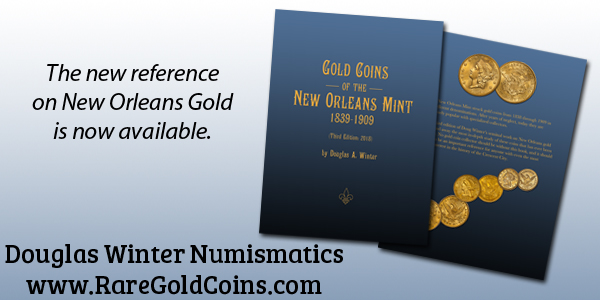
SELECTIONS FROM DAVISSON'S E-AUCTION 34
Here are some items that caught my eye in the Davisson's E-Auction 34 closing February 5, 2020. First, here's some new year commentary from Allan Davisson's January 10, 2020 email blast. -Editor
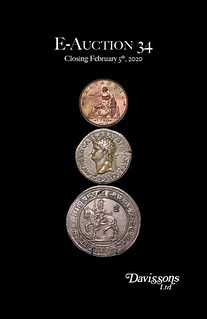 Welcome to another decade! Marnie and I have been reminiscing…. The last ten years have seen momentous changes in our lives, as we welcome grandchildren, and as we
continue to experience the remarkable remaking of our business by our son and partner Lief, who has orchestrated the building of our internet auction platform and brought our
business into the 21st century in many different ways.
Welcome to another decade! Marnie and I have been reminiscing…. The last ten years have seen momentous changes in our lives, as we welcome grandchildren, and as we
continue to experience the remarkable remaking of our business by our son and partner Lief, who has orchestrated the building of our internet auction platform and brought our
business into the 21st century in many different ways.
Our enthusiasm and approach to numismatics is rooted in the centuries-old enthusiasm for art and history of coinage that began with Romans collecting Greek coins, but the presentation to a world-wide community of coin enthusiasts via the internet is far beyond anything we could imagine in the early 1990’s when we were still doing black-and-white photography with a Polaroid camera mounted on a copy stand. My first effort at publishing color photographs involved working with a professional photographer whose gang-shot images could be converted to color after we paid a pre-press shop to do the work. (My memory? It was expensive and a bit disappointing when we finally got the print catalog in hand.)
We still use the copy stand, but Lief has mastered the art of coin photography, going well beyond my experience. He uses pre-press programs on our own computers to bring the color photographs to our catalogs and our website that show you much more than the black-and-white images we presented early on. But we still favor the detailed written descriptions we used in those old black-and-white days, so that you have a clear idea of what you can expect.
This catalog? Ordinarily we begin the calendar year with our largest sale of the year, filled with some of our choicest material. That sale is well along in production and will close in March. But we have some things for you to consider now: a New Year Store Sale, some good and some great pieces that slipped through earlier sales and deserve a second look (and at lower estimates); some coins that have come to us looking for new owners, keepers of these bits of history; and some select pieces that could have fit in the bigger sale but seem particularly suitable for our first E- Auction of the new decade.
Lot 2: 1913 French 20 Francs
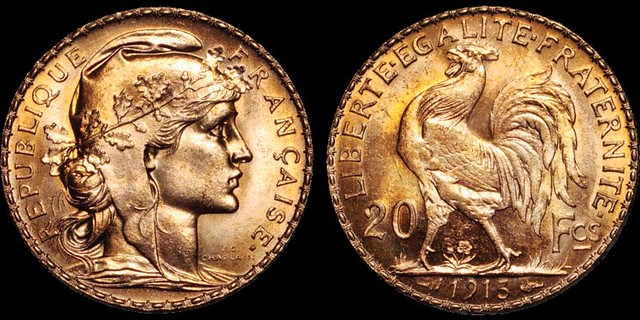
FRANCE. AV 20 francs. 6.46 gm. 21 mm. .1867 oz AGW. 1913. Liberty head right / Rooster left. KM 857. Friedberg 596a. Uncirculated.
What's not to like about a pretty gold coin? -Editor
To read the complete lot description, see:
E-Auction 34 Lot 2 (https://davcoin.com/lot/e-auction-34-lot-2)
Himera Gorgon Head Hemilitron
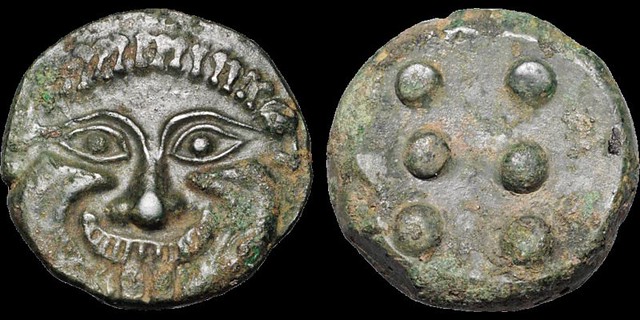
SICILY. Himera. Circa 430 B.C. Æ hemilitron. 15.03 gm. 23 mm. Cast coinage, reduced standard. A facing Gorgon with protruding tongue and furrowed cheeks / Six pellets (mark of value). CNS I p. 34, 24. SNG ANS 180.
I have a soft spot for goofy Gorgon heads. -Editor
To read the complete lot description, see:
E-Auction 34 Lot 9 (https://davcoin.com/lot/e-auction-34-lot-9)
Lot 62: Coenwulf Penny
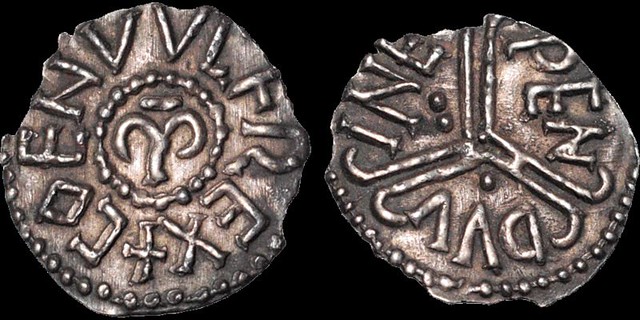
ANGLO-SAXON. Kings of Mercia. Coenwulf. 796-821. AR penny. 1.29 gm. 18 mm. Tribrach type. London mint, Pendwine moneyer. Circa 797/8-805. A Mercian M with a short horizontal line above, a pellet circle around / A tribrach moline; PEN | DVV | INE in angles. S. 914. N. 342. Naismith L14a (this coin). Very Fine; rare moneyer.
Ex Delgany Hoard (1874).
Ex Evans (1908).
Ex Lord Grantley (1944).
Ex Blunt, Lyon and Stewart 1963, Coenwulf 17.
Ex SNC XCVIII.6: 4230.
Ex Patrick Finn (1997).
Ex Triton II (1998).
Nice coin with a provenance from 1874. -Editor
To read the complete lot description, see:
E-Auction 34 Lot 62 (https://davcoin.com/lot/e-auction-34-lot-62)
Lot 86: 1818 George III Half Crown
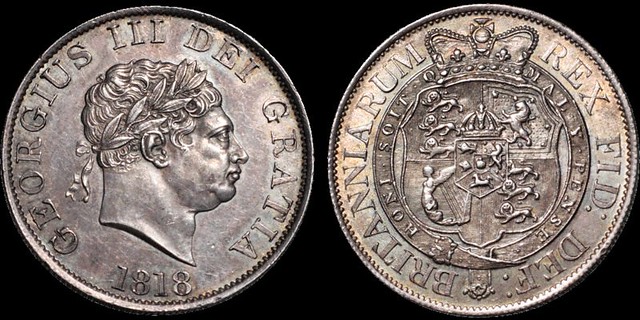
George III. 1760-1820. AR halfcrown. 14.17 gm. 31 mm. 1818. His laureate small head right; GEORGIUS III DEI GRATIA 1818 around / Crowned shield in garter; REX FID: DEF: — BRITANNIARUM. S. 3789. ESC 2099 (628).
A strong portrait and bold legends. Nice coin design. -Editor
To read the complete lot description, see:
E-Auction 34 Lot 86 (https://davcoin.com/lot/e-auction-34-lot-86)
Lot 158: Vigo Bay Medal
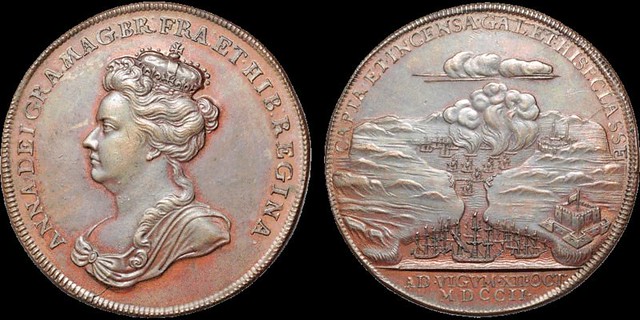
GREAT BRITAIN. Anne. 1702-1714. Æ medal. 17.46 gm. 37 mm. Expedition to Vigo Bay. By J. Croker. 1702. Her crowned bust left; ANNA DEI GRA MAG BR FRA ET HIB REGINA / View of ships in Vigo Bay, the Spanish and French ships burning; CAPTA ET INCENSA GALET HISP CLASSE around, AD VIGVM XII OCT MDCCII in two lines below. Eimer 395.
Vigo coins too dear for your budget? How about a Vigo Bay medal? -Editor
To read the complete lot description, see:
https://davcoin.com/lot/e-auction-34-lot-158 (https://davcoin.com/lot/e-auction-34-lot-158)

SELECTIONS FROM ROBINSON SALE 111
Here are a few items that caught my eye in Frank Robinson's Auction 111 closing February 11, 2020. First some new years commentary from Frank about coin photography. -Editor
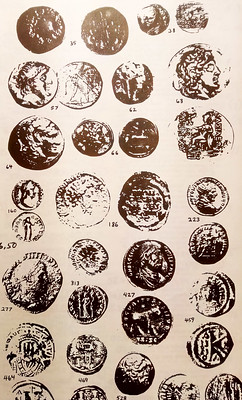 IN THE BEGINNING . . . of my auctions, in 1985, I made coin pictures on a xerox machine. How bad were they? Have a laugh! — www.fsrcoin.com/xerox.jpg
IN THE BEGINNING . . . of my auctions, in 1985, I made coin pictures on a xerox machine. How bad were they? Have a laugh! — www.fsrcoin.com/xerox.jpg
Then I got a state-of-the-art “Lepcyzk box.” Named for auctioneer Joe Lepcyzk, it had a built-in Polaroid camera and lighting, to photograph several coins at a time. Initially, I used it to provide photos on request, charging $1 per shot, the cost of film. Then around 1995 I started sending out, with auctions, a printed sheet of about 100 coin pics. Making the layout was very time-consuming (and the film and printing were expensive).
Then new technology: a scanner, with photos produced on my printer. Picture quality was better, but there was still the tedious cut-and-paste.
Eventually I progressed to a digital camera, making my own set-up stage, and now, instead of printing, putting pictures online, of every lot: in layouts of twenty or so coins together in each image.
As other online auctions proliferated, I had to raise my game again, to now show individually each coin's obverse together with the reverse. I never did figure out an efficient way to get them side-by-side. Still, it took around 30 hours of work, with individual coin photoshopping of brightness/contrast, color, etc.
Ever trying for improvement, I did some research and got a better digital camera. A problem is lower resolution and increasing distortion outside the center of an image, limiting the number of coins in each shot.
When I mentioned to my wife starting on the pictures for this latest sale, she remarked, “My new phone has a really good camera.” It’s not an iPhone or other top-of-the-line model. But I tried it — with definitely better results. I could do more coins in each shot, with better image quality, needing less photoshop adjustments.
Ever upward. One day we’ll be uploading the pictures directly into bidders’ brains.
Happy New Year
Lot 31: "Make Dioskourias Great Again"
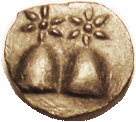
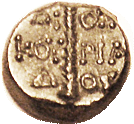
DIOSKOURIAS, Æ16, 1st-2nd cent BC, Caps of the Dioscuri inscribed "Make Dioskourias Great Again" (in Greek of course; stars above/Thyrsos & lgnd; S3629; Choice VF-EF, unusually good centering for this with obv design virtually complete, rare thus; smooth olive-brown patina.
Nice coin. -Editor
Lot 38: Kamnaskires V
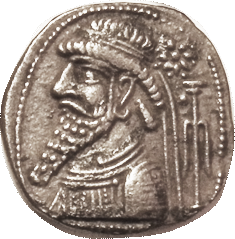
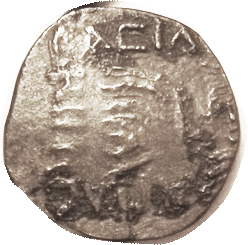
38 Kamnaskires V, 54-33 BC, Ar Tet, Bearded bust l., anchor at rt, star above/ lgnd & bearded bust left, GIC 5884 (£250); VF, obv perfectly centered & well struck, unusually good; rev typically very crude & weak. Silver with lt grey-brown tone.
Gotta love the big pointy beard. -Editor
Lot 51: Istros Stater
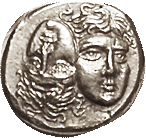

ISTROS, Stater or Drachm, 400-350 BC, Two facg hds, left inverted/Eagle atop dolphin, A below, as S1669 (£225); Nice EF, good centering & strike with heads complete & well detailed; decent bright silver. Much above average. Some scholars suggest the heads represent the Dioskuroi. Others say Bert & Ernie.
Very unusual design! -Editor
Lot 72: Antigonos Gonatas
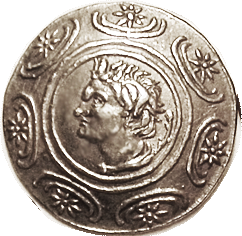
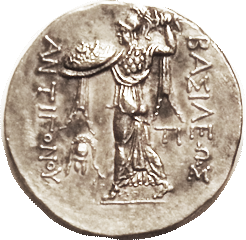
Antigonos Gonatas, 277-239 BC, Tet., Pan head in shield/ Athena Alkidemos stg l, helmet in field, TI at rt; Choice EF, well centered amp;& struck, good metal with lt tone, unusually nice example with strong detail. Scarcer variety.
Lot 358: Majorian
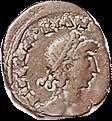
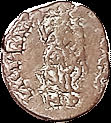
MAJORIAN, Æ4, VICTORIA AVGGG, Victory stg l, MD, LRBC 582, RIC 2645; F-VF or better for this, obv sl off-ctr, lgnd off at rt but MAIORIAN present, rev sl crude with lgnd partly off at rt, mintmk quite clear. Lt brown with traces of pale green. Portrait fully clear. Really a good example, which most anyone else would grade VF (as did I, on my original envelope). Very rare -- more so than his gold. I got this, unidentified, out of a bagful of small late bronzes. Oddly enough, years later, I found an even nicer one for my collection, in the same way — from the same dealer! (A "VF" [but rough, off-ctr & weak] brought $1700, Artemide 4/07.)
For more information, or to bid, see:
http://fsrcoin.com/j.html
THE BOOK BAZARRE
RESTRICTIVE TURKEY, TUNISIA AGREEMENTS, PART 2
Max Fox submitted this follow-up to last week's article on the potential agreements with Turkey and Tunisia which could have a large impact on coin collecting in the U.S. Thanks. -Editor
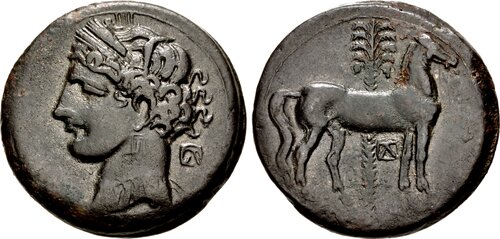
The results of the comment period for the proposed MoUs between the U.S. and the Republics of Turkey and Tunisia are in. In total, almost 99 usable electronic public comments
were received and posted on the Regulations.gov website:
https://www.regulations.gov/docket?D=DOS-2019-0043
This is not great, but not terrible either. A lot from both sides voiced their concerns over several different, but equally important, issues. Two important organizations, for instance, namely the American Hellenic Institute (AHI) and the Committee for Cultural Policy and Global Heritage Alliance were not thrilled with the Turkish request (to say the very least), and based a part of their strong opposition to the proposed MoU on the grounds of denying large American populations of Armenians, Greeks, and other peoples who had once called the land of modern Turkey their home, antiquities that their very ancestors had made and/or owned. We know from history that some of the same people were forcibly dispossessed of them too, in the last two centuries. As for the Tunisian request, the latter organization (CCP & GHA) echoed my own comment on Tunisia's puzzling dearth of evidence of illicit material residing in the U.S. Read their request over again. It is amazing in a lackluster way. For some of these reasons alone, it would be good to show our support for both organizations, which brings us to my next point.
In my previous post, I had forgotten to mention that "the Cultural Property Advisory Committee will hold an open session on January 21, 2020," in which the public is
invited to participate (either in person or electronically by Zoom). More information on how to attend can be found on the website here:
https://www.regulations.gov/document?D=DOS-2019-0043-0001
Also, interested parties can download a PDF copy of the following issue of the Federal Register which appears to contain much of the same information:
https://www.regulations.gov/contentStreamer?documentId=DOS-2019-0043-0001&contentType=pdf
Very important: if anyone wishes to speak at the meeting, they must be registered " via email (culprop@state.gov) in order to be assigned a slot" no later than January 14.
Because of the questionable nature of both MoUs, especially in light of current world events and even the Cyprus question, it is actually more uncertain this time which direction the upcoming CPAC meeting will take.
To read the earlier E-Sylum article, see:
RESTRICTIVE TURKEY, TUNISIA AGREEMENTS PENDING (https://www.coinbooks.org/v23/esylum_v23n01a27.html)
GOLD BAR WAS LOOTED AZTEC TREASURE
A gold bar found in Mexico City in 1981 has been determined to have been part of part of the Aztec treasure looted by Spanish conquistadors. -Editor

A gold bar found in a Mexico City park in 1981 was part of the Aztec treasure looted by Hernan Cortes and the Spanish conquistadors 500 years ago, a new study says.
The 1.93-kilogram bar was found by a construction worker during excavations for a new building along the Alameda, a picturesque park in the heart of the Mexican capital.
For 39 years, its origins remained a mystery.
But thanks to specialized X-rays, Mexico's National Institute of Anthropology and History (INAH) says it has now confirmed where the bar came from: the Spaniards' hasty, though temporary, retreat during the so-called "Noche Triste," or "Sad Night."
That night -- June 30, 1520 -- the Aztecs, furious over the slaughter of their nobles and priests, drove the Spanish invaders from their capital, Tenochtitlan.
The conquistadors escaped with as much looted Aztec treasure as they could carry, including, apparently, the gold bar in question.
To read the complete article, see:
Gold bar found in Mexico was Aztec treasure: study
(https://artdaily.cc/news/119957/Gold-bar-found-in-Mexico-was-Aztec-treasure--study#.XhnZzEdKhPY)
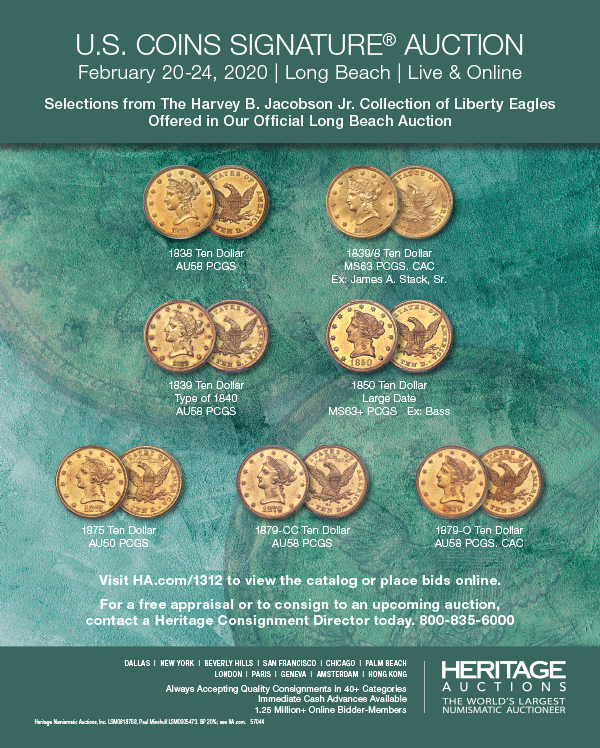
THE CZECH TOWN THAT INVENTED THE DOLLAR
Dick Hanscom, Chip Howell and Kavan Ratnatunga passed along this nice BBC Travel Series article by Eliot Stein about the birthplace of the dollar. It's well-written and researched. See the complete article online for more. -Editor
 The US dollar is the most widely used currency in the world. It is both the primary de facto global tender and the world’s unofficial gold standard. According to the
International Monetary Fund, 62% of the planet’s financial reserves are held in US dollars – more than double the total foreign holdings of euros, yen and renminbi combined.
Thirty-one nations have either adopted it as their official currency or named their money after it; more than 66 countries peg the value of their currencies to it; and it’s now
accepted in places as far-flung as North Korea, Siberia and research stations on the North Pole.
The US dollar is the most widely used currency in the world. It is both the primary de facto global tender and the world’s unofficial gold standard. According to the
International Monetary Fund, 62% of the planet’s financial reserves are held in US dollars – more than double the total foreign holdings of euros, yen and renminbi combined.
Thirty-one nations have either adopted it as their official currency or named their money after it; more than 66 countries peg the value of their currencies to it; and it’s now
accepted in places as far-flung as North Korea, Siberia and research stations on the North Pole.
Yet, one place where the dollar is not accepted is in the tiny Czech town of Jáchymov – which is ironic, because it was here, tucked deep into the wooded folds of Bohemia’s Krušné hory mountains, where the dollar originated 500 years ago in January 1520. But as I pulled a George Washington one-dollar bill from my wallet in Jáchymov’s 16th-Century Royal Mint House museum, the very spot where the dollar’s earliest ancestors were coined, docent Jan Francovic smiled and stopped me.
“I haven’t seen one of these in a long time,” he said, calling over two colleagues. “In Jáchymov, we only accept koruna, euros or sometimes Russian rubles. You’re the first American to come here in more than three years.”
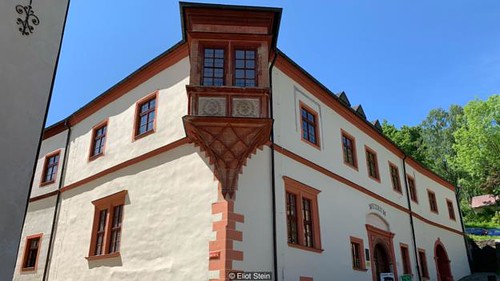
Joachimsthal Royal Mint house museum
Long before Jáchymov existed, the rolling mountains separating modern-day Bohemia and Saxony were ruled by wolves and bears who roamed its virgin forests. When vast quantities of silver were discovered in 1516, enterprising local nobleman Count Hieronymus Schlick christened the area Joachimsthal (“Joachim’s valley”) after Jesus’ grandfather, the local patron saint of miners.
“At the time, Europe was a continent of city-states with local rulers vying for power,” explained local historian Jaroslav Ochec. “With no standard monetary unit among them, one of the most effective ways rulers could assert their control was to mint their own currency, and that’s what Schlick did.”
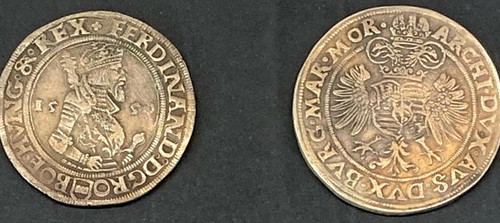
The governing Bohemian Diet officially granted Schlick permission to mint his silver coins on 9 January 1520. The count stamped an image of Joachim on the front, the Bohemian lion on the back, and named his new currency “Joachimsthalers” – which soon became shortened to “thalers”.
In an age when the metal content of coins was the sole determinant of value, Schlick did two smart things to ensure the thalers’ spread and survival. First, he made the thaler the same weight and diameter as the 29.2g Guldengroschen coin used throughout much of central Europe, which made it easier for neighbouring kingdoms to accept it. More importantly, he minted more coins than the world had ever seen.
In just 10 years, Joachimsthal transformed from a 1,050-person hamlet to the largest mining centre in Europe – a bustling 18,000-person hub with 1,000 silver mines employing 8,000 miners. By 1533, Joachimsthal was the second-largest city in Bohemia after Prague, and by the mid-16th Century, Urban estimated that some 12 million thalers minted from these mountains had spread across Europe – far more than any other currency on the continent.
Joachimsthal’s silver deposits soon ran dry, but by 1566, the thaler was so well known across Europe that when the Holy Roman Empire sought to establish a standard size and silver content for the many local currencies in its kingdom, it chose the thaler, calling all acceptable silver coins “Reichsthalers” (“thalers of the empire”).
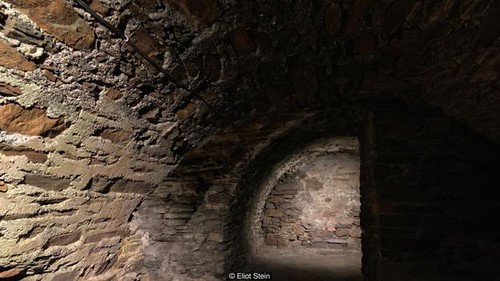
The dark, vaulted basement below the Royal Mint House is where the first thalers were assayed
“For the next 300 years, many countries around the world modelled their money after the thaler,” Urban said, staring across Jáchymov’s rusted metal roofs towards the hulking white shaft of Europe’s oldest continuously operated mine and the Schlick castle, which both still loom over the town. “Soon, the thaler started to live a life of its own far from here.”
There are still no signs anywhere in Jáchymov stating its rightful claim as the birthplace of the dollar. But if you head inside the town’s Royal Mint House museum and ask the docents to show you what’s new for this year’s quincentenary, they’ll proudly point behind the desk and show you a small frame holding a crisp new George Washington.
To read the complete article, see:
Welcome To Jchymov the Czech Town That Invented the Dollar
(http://www.bbc.com/travel/story/20200107-welcome-to-jchymov-the-czech-town-that-invented-the-dollar)
For more information on the Jáchymov Royal Mint House museum, see:
Jáchymov Royal Mint House (http://www.zivykraj.cz/en/discover/jachymov-royal-mint-house)

SYMBOLS ON AMERICAN MONEY: THE EAGLE
Pablo Hoffman of New York City forwarded this excerpt from the 1957 pamphlet Symbols on American Money by Stephen L. Goldsmith via the Delancey Place blog. Thanks! -Editor
"[It is] the reverse side of the $1 note that holds the most meaning. Our Founding Fathers were deeply aware of the importance of symbols. In fact before the adjournment of the Continental Congress on July 4, 1776, a committee was appointed to create a seal that would symbolize America's ideals. The committee included John Adams, Thomas Jefferson and Benjamin Franklin—three of the drafters of the Declaration of Independence.
"However, designing the seal was a difficult and controversial undertaking that spanned six years and three committees. The final proposal as accepted by Congress was submitted on June 13, 1782 by Charles Thomson, a prominent Philadelphia merchant and secretary of the Continental Congress. He is credited with finalizing the design—unifying the ideas of the three committees, their consultants and artists.
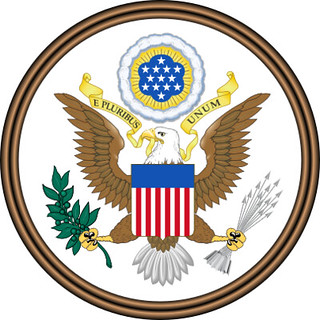 "The result was the Great Seal of the United States and hidden within it are the messages our Founding Fathers wanted to send to future generations of Americans.
Today the two most prominent features on the back of the $1 note are the pyramid and the eagle, which together constitute the Great Seal of the United States.
"The result was the Great Seal of the United States and hidden within it are the messages our Founding Fathers wanted to send to future generations of Americans.
Today the two most prominent features on the back of the $1 note are the pyramid and the eagle, which together constitute the Great Seal of the United States.
"To solve the mystery of what these symbols mean, we go directly to the source, Charles Thomson who presented his written description of the Great Seal to Congress on June 20, 1782. The most striking feature of the front of the seal is in Thomson's words 'an American Eagle on the wing and rising.' The eagle flies freely, independent of any support, holding in its left talon 13 arrows signifying war and in its right talon an olive branch signifying peace.
"You may think which talon holds the arrows and which holds the olive branch is of little consequence. But in the language of symbols it is of great significance. The right side signifies dominance. Therefore arrows depicted in the eagle's right talon can be interpreted as a warlike gesture. Failure to adhere to this concept almost got the United States into a war.
"From 1801 to 1807, the eagles on the backs of our silver coins were inadvertently shown with the arrows in the right talon instead of the left. Some European journalists and diplomats interpreted this as an expression of American belligerence and tried to use it as grounds for promoting war with the United States. In response, a new design was created in 1807 for the backs of American silver coins. This time the olive branch—representing peace—was placed in the dominant right talon, putting an end to the journalistic saber rattling. The eagle holds a banner in its beak with the words 'E Pluribus Unum', which Thomson translates to mean 'Out of many one.'
"Thomson goes on to explain that the shield or escutcheon on the eagle's breast is composed of two major parts: a horizontal blue band which represents Congress extending across the top third of the shield, supported by 13 red and white vertical stripes, which represent the 13 original colonies. The 13 stars above the eagle represent a new constellation taking its place in the universe in the same way that a new nation takes it place among the other sovereign nations. The colors also have significance. Blue stands for vigilance perseverance and justice; red signifies hardiness and valor; and white indicates purity and innocence."
For illustration, here are the reverses of 1807 Draped Bust and Capped Bust half dollars. Images from PCGS CoinFacts. -Editor
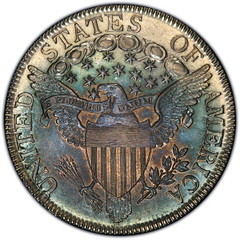
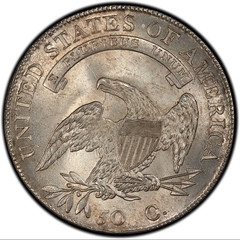
Can anyone recommend a good article or chapter in numismatic literature about the topic of the arrows and eagle talons? The Newman Portal has a large number of references to the talons, but I found it hard to narrow down the search.
To read the complete article, see:
THE EAGLE (https://delanceyplace.com/view-archives.php?p=4011)
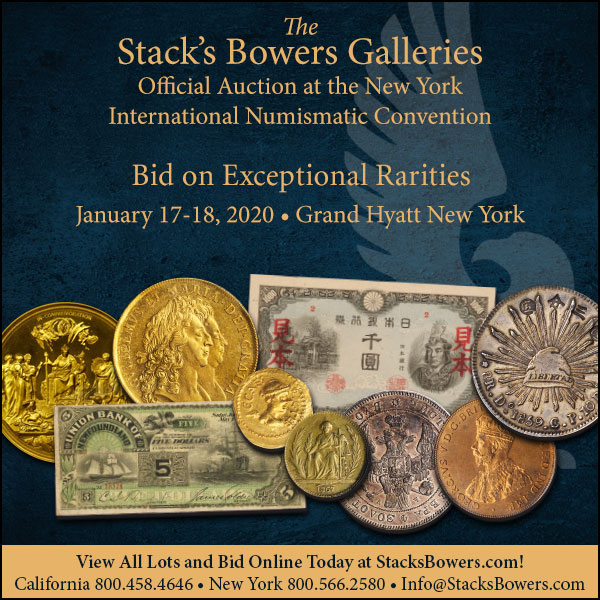
STACK’S BOWERS OFFERS 1884 AND 1885 TRADE DOLLARS
This Stack’s Bowers press release highlights two legendary rarities to be auctioned by the firm in March. -Editor
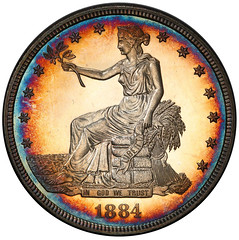
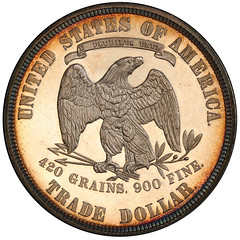
Stack’s Bowers Galleries is proud to continue their tradition of presenting world-class rarities at auction by featuring 1884 and 1885 Proof trade dollars in their March 18-20, 2020 Baltimore Auction.
The 1884 and 1885 trade dollars are legendary U.S. Mint rarities, ranking #78 and #15 respectively among the 100 Greatest U.S. Coins (Garrett & Guth, 2019). While the Mint had ended production of circulation-strike trade dollars in 1878, Proof examples were officially distributed in Proof sets through 1883. Additional Proof examples were struck at the beginning of 1884, but were never distributed and all but 10 were eventually melted. It is believed that a similar situation occurred in 1885, leaving just five examples of that date for collectors today.
With such small populations, the rarity of these trade dollars rivals or surpasses such numismatic icons as the 1913 Liberty Head nickel (five examples known) and the 1804 dollar (15 examples known). They are more infrequently offered at auction than these similar, but perhaps more famous issues. Every appearance is a historic opportunity.
Acquiring one of these trade dollars represents a monumental numismatic prize; the inclusion of both has been a hallmark of only the most fabled and accomplished United States coin collections. It has been 17 years since Stack’s Bowers Galleries last offered both dates in the same sale, their May 2003 presentation of the L.K. Rudolph Collection. Prior to that, six years had passed since the April 1997 sale of the Eliasberg specimens, and over a decade since the L.R. French (1989), Norweb (1988), and Amon Carter (1984) examples were offered in its sale rooms. The pair of rarities to be presented in the March 2020 Baltimore sale have not appeared at auction in over three decades.
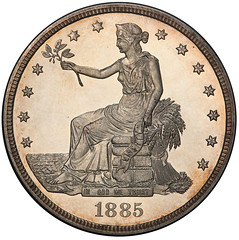
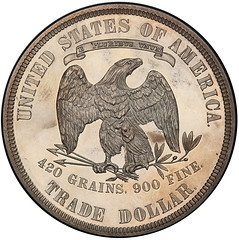
“Stack’s Bowers Galleries is the only numismatic firm to have handled every known 1884 and 1885 trade dollar,” stated Stack’s Bowers President Brian Kendrella. “In fact, we have sold some of them several times over our 85- year history.”
At Proof-64+ Cameo (PCGS), the 1884 ranks as the fourth finest certified of the 10 known examples. It first appeared on the market in an ad placed by dealer Edgar Adams in the March 1915 issue of The Numismatist. It has since resided in several significant cabinets, including those of Waldo C. Newcomer, Colonel E.H.R. Green and Amon G. Carter, Jr. It last was offered at auction as lot 440 in Stack’s January 1984 sale of the Carter Family Collection.
The 1885 example is certified Proof-64 (PCGS) and ranks as the second finest certified behind only the Eliasberg specimen (Proof-65+ Cameo PCGS). It was first offered at auction in B. Max Mehl’s sale of the Fred Olsen Collection in November 1944 amidst the chaos of the World War II. Two decades later it appeared in Stack’s November 1965 sale of the George Ewalt Collection. It most recently appeared at auction as lot 202 in Stack’s sale of the L.R. French Collection in January 1989.
These two trade dollars will be offered in Stack’s Bowers Galleries March 2020 presentation of further items from the E. Horatio Morgan Collection, an incredible cabinet of rarities assembled primarily in the late 1980s and early 1990s. The March Baltimore sale marks the third offering from this exceptional collection, with earlier selections featured in the firm’s August 2019 ANA and November 2019 Baltimore auctions. Built with a focus on dimes, half dollars, and select major rarities, highlights from the collection included a Choice Proof 1894-S dime, a Gem 1876- CC twenty cent piece, a Choice Proof 1838-O half dollar, and a nearly-complete set of half dollars by die variety from 1794 through 1836. With the inclusion of these two monumental trade dollars, the E. Horatio Morgan Collection has surely secured a place among the most storied collections of United States numismatics.
The Proof-64+ Cameo (PCGS) 1884 trade dollar and the Proof-64 (PCGS) 1885 trade dollar will be displayed by Stack’s Bowers Galleries at their table at the 2020 FUN Convention in Orlando, Florida, beginning on Thursday, January 9th.
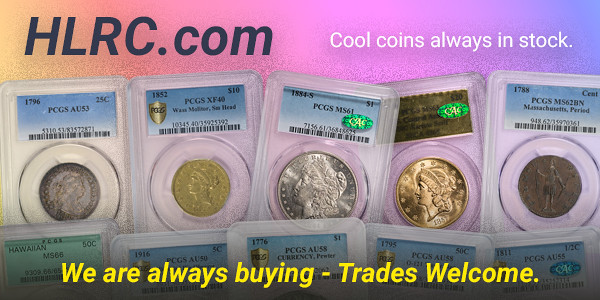
MORE ON THE BURKE & HERBERT BANK VAULT
Bill Eckberg writes:
Tom’s piece about the Burke & Herbert bank was fascinating. I have also heard that an old chest was found in the basement of B&H a few years ago that belonged to Robert E. Lee was and given to descendants. It may be apocryphal, but it’s interesting.
True story, actually. And there were two trunks. A July 15, 2007 story from the Richmond Daily Herald recounts how the trunks (belonging to Lee's eldest daughter) was rediscovered after 84 years in storage. -Editor
Two old steamer trunks sit in the rare-book room at the Virginia Historical Society, looking worn and forlorn. The smaller one was once red but the paint has faded to a dull rust. The larger one is brown with a piece of tin patching a hole. On one side, a name is stenciled: "M. LEE."
That's Mary Custis Lee, Gen. Robert E. Lee's adventurous eldest daughter. In 1917, she stored these wooden trunks in the "silver vault" in the basement of Burke & Herbert Bank & Trust in the Washington suburb of Alexandria, Va. A year later, she died at 83. Her trunks sat in a dusty corner of the vault for 84 years, unclaimed, until Hunt Burke, the bank's vice chairman, discovered them in 2002.
Burke called his high school classmate Rob E.L. deButts Jr., Robert E. Lee's great-great-grandson. Together, the two men descended into the vault. Burke carried a basket of old keys.
"The first one I pulled out was a perfect fit," he said.
The trunks were stuffed with Lee family papers: a priceless cache of 4,000 letters, photographs and documents. DeButts carted them here to the Virginia Historical Society, which houses the world's largest collection of Lee papers. He spent a week there, picking out treasures and trash from Mary Custis Lee's trunks.
Buried deep in one trunk was a letter that former slave Selina Gray wrote to Robert E. Lee's widow, the woman who'd once owned her. It's one of several letters to reveal the complex relationship between the Lees and African Americans.
"Mrs Lee, I received your letter and was happy to hear from you," Gray wrote in 1872, "and I was hoping to see you once more at Arlington."
Arlington had changed since Mrs. Lee had last seen it in 1861, when the Union Army occupied her family home.
To read the complete article, see:
Daughter's trunks tell much about
Lee (https://www.heraldextra.com/lifestyles/daughter-s-trunks-tell-much-about-lee/article_7efeaef5-f4b7-54d3-a292-57ccff90c698.html)
Things have changed even since 2007. A reporter in 2020 would probably write "formerly enslaved person" instead of "former slave" and "once enslaved" vs. "once owned." See the complete article online for much more - it's a fascinating, if non-numismatic story.
If you missed the article last week, follow the link below. We'd still like to hear from readers their thoughts on what sort of financial instruments could have been used to smuggle the bank's fortune out of Virginia during the Civil War. -Editor
To read the earlier E-Sylum article, see:
SAVING THE WASHINGTON FAMILY FORTUNE (https://www.coinbooks.org/v23/esylum_v23n01a23.html)
LADY GODIVA AND THE TOKENS OF COVENTRY
On his Stack's Bowers blog this week Jeremy Bostwick published an article about Lady Godiva and the trade tokens of Coventry. -Editor
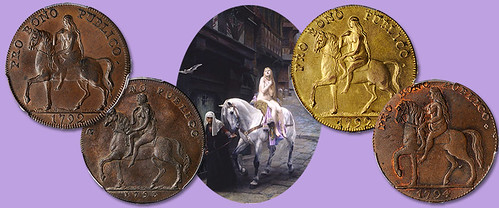
Possibly better known now due to her association with a brand of chocolates, the Lady Godiva in Anglo-Saxon days was a noblewoman married to Leofric, the Earl of Mercia in what is now central England. Though the legend surrounding her is viewed today rather apocryphally, it nevertheless has survived for at least seven centuries at least in part because of its risqué nature. The story dates to the 13th century, while Godiva herself (Godgifu in Old English) floruit around the time of the Norman invasion in 1066. Sympathetic toward the citizens of Coventry as a result of the burdens of taxation levied by her husband, she beseeched him repeatedly to cease with his oppressive taxes, with each entreaty being quashed.
Finally, having grown weary of Godiva's many requests, Leofric acquiesced, stating that he would grant her wish solely on the condition that she would strip naked and ride a horse through the streets of Coventry. Taking him at his word, she did just that, clad only in her long hair that, in the world of art, is often "strategically" used to cloth her. Upon her agreement to the proposal, Leofric issued a commandment that the townsfolk look away and remain indoors, lest they see his wife's unclothed state. All but one—a man named Thomas—obeyed this order. Poor Thomas, having caught an illicit glimpse at the naked countess, was allegedly struck blind. From this tale, the notion of a "peeping Tom" originated and persists in the vernacular to this day.
The legendary "naked ride" is still celebrated widely in Coventry, with numerous references in the form of monuments, art, and a festival. An unclothed female upon a horse is even on the city's flag and coat-of-arms. It is clear that, despite its rather dubious origin, the tale is treated as a civic badge of honor. In numismatics, this is abundantly clear, with numerous late-18th century Coventry trade tokens employing this popular iconography. On these pieces, Lady Godiva is presented riding left upon a horse, seated sidesaddle toward the viewer and modestly attempted to cover herself.
Our upcoming Collectors Choice Online (CCO) auction in February will offer a charming selection of these "Lady Godiva" tokens, presenting different years, reverse types, and artistic renditions of the countess. Though it is more likely that this event did not occur, it is rather fitting that the ride—for which the alleged purpose was the lowering of taxes to aid the local economy—eventually made its way onto a form of token specie meant to alleviate the current coining shortage and facilitate the commerce of not just Coventry, but of the United Kingdom as a whole.
To read the complete article, see:
The Legend of Lady Godiva and the Trade Tokens of Coventry
(https://www.stacksbowers.com/News/Pages/Blogs.aspx?ArticleID=the-legend-of-lady-godiva)

MICROMOSAIC COINS: GIRL WITH A PEARL EARRING
Lou Golino's January 8, 2020 CoinWeek article discusses the most profitable modern coins of 2019. One recent issue I was unfamiliar with was the "Girl with a Pearl Earring" micromosaic coin. Here's an excerpt. -Editor
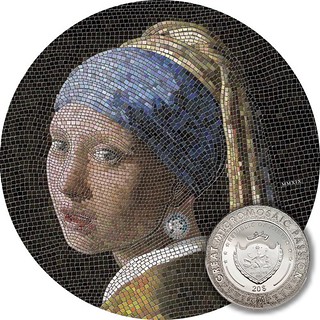 There were a number of world issues that did well in 2019, but in terms of increase from issue price to current value, the best was probably the third release in Italian
dealer Powercoin’s “Micromosaic Passion” series of three-ounce Proof coins issued for Palau that recreate famous art masterpieces using thousands of carefully arranged colored
tiles. The 2019 coin is called “Girl with a Pearl Earring,” and depicts the famous 17th-century painting of Dutch master Johannes Vermeer.
There were a number of world issues that did well in 2019, but in terms of increase from issue price to current value, the best was probably the third release in Italian
dealer Powercoin’s “Micromosaic Passion” series of three-ounce Proof coins issued for Palau that recreate famous art masterpieces using thousands of carefully arranged colored
tiles. The 2019 coin is called “Girl with a Pearl Earring,” and depicts the famous 17th-century painting of Dutch master Johannes Vermeer.
The coin was in pre-order from the spring with an issue price of around 400 euros that quickly increased as demand vastly outstripped the supply of this coin. Powercoin’s director Antonello Galletta said that he received orders from distributors for five times the amount of coins minted (which remains at 499 like the first two issues in the series). The coin hit the streets at the very end of the year with just a limited portion of mintage, and the remaining coins should be available by the end of January.
There were only two recent sales of the coin on eBay for $839 and $929, and there are four current Buy It Now offers between $850 and $1,500. This coin benefitted from the huge success of the first issue, the Birth of Venus in 2017, which won a Coin of the Year Award for Most Innovative Coin in Berlin in 2019 and a 2018 Coin Constellation award in 2018 in Moscow, and whose value is around $2,000 today (with the latest sales at $1,556 and $2,456), and the success of the second coin in 2018, the Mona Lisa issue. Antonello said the series will continue in 2020 and end in 2021 with the fifth issue.
Interesting method of manufacture. Nice coin. I have a framed poster of Vermeer's "Girl with a Pearl Earring" here on my library wall from a 1982 National Gallery of Art exhibit. -Editor
To read the complete article, see:
The Coin Analyst: The Most Profitable Modern Coins of 2019
(https://coinweek.com/modern-coins/the-coin-analyst-the-most-profitable-modern-coins-of-2019/)
ENGLAND’S FIRST RECORDED STATE LOTTERY
Early lottery tickets are often collected and studies as an adjunct to early paper money. Saturday's Writer’s Almanac marked the anniversary of England’s first state lottery, based on an earlier Smithsonian article. -Editor
Elizabeth I held England’s first recorded state lottery on this date in 1569. The queen needed to raise funds to rebuild some harbors and make England more competitive in global trade, so she instituted the lottery for “reparation of the havens and strengths of the Realme and towards such other public good works.” Her lottery was limited to 40,000 entries of 10 shillings each — too steep a price for most commoners. People lined up at the west door of St. Paul’s Cathedral in London to buy their tickets. The winner’s name has been lost to us. The prize was 5,000 pounds, part paid in cash and the rest paid in tapestries, plate, and good linen cloth. To sweeten the pot even further, the queen offered all entrants a “get out of jail free card” for all crimes besides murder, treason, piracy, and other felonies. The total jackpot was equal to the number of tickets sold, but the prize wasn’t paid out for three years, so the crown enjoyed an interest-free loan.
Government learned a valuable lesson: the lottery — sometimes known as a “voluntary tax” — is a great way to bring in some extra revenue to fill state coffers.
As Henry Fielding wrote in his play The Lottery (1732): “A lottery is a taxation upon all the fools in creation; and heaven be praised, it is easily raised, for credulity’s always in fashion.”
Curious, I went looking for a surviving example of one of the lottery tickets. Does one exist? An online search turned up some more articles and videos, but the only image with a contemporary connection is a broadside announcing the lottery, found on the site of the British Library. -Editor

This is an advertisement for England’s first ever National Lottery. It was issued in 1567 by Queen Elizabeth I. At this time England was seeking to expand its export markets around the world. The lottery was intended to raise money for the enormous costs of building ships and developing ports. Tickets cost ten shillings each – far too much for the ordinary citizen to afford. The first prize was an amazing £5000...
To read the complete article, see:
The Writer’s Almanac for Saturday, January 11, 2020
(http://www.garrisonkeillor.com/radio/twa-the-writers-almanac-for-january-11-2020/)
To read the Smithsonian article, see:
Queen Elizabeth I Held England’s First
Official Lottery 450 Years Ago (https://www.smithsonianmag.com/smart-news/queen-elizabeth-i-held-englands-first-official-lottery-nearly-450-years-180957804/)
To read the British Library article, see:
The Great Lottery 1567 (https://www.bl.uk/learning/timeline/item102765.html)
For more, see:
It Coulde Be Ye! First lottery was held 450 years ago... with a
£5,000 jackpot (https://www.dailymail.co.uk/news/article-1285543/Britains-lottery-held-450-years-ago--5-000-jackpot.html)
11th January 1569: First recorded lottery drawn in England under Elizabeth I
(https://www.youtube.com/watch?v=Aem4hitouLg)
LOOSE CHANGE: JANUARY 12, 2020
Here are some additional items in the media this week that may be of interest. -Editor
The Kyle Ponterio Collection
Jay Turner penned a nice article for PCGS on the Kyle Ponterio collection. -Editor
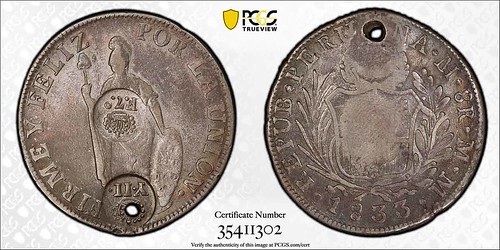
If you ever meet someone with a real passion, there is a genuine excitement there. It is a love and devotion that cannot be faked, something that has been achieved through hard work and dedication. This passion from many people can be addictive, and every time I talk to Kyle Ponterio, I see this passion, and I learn from it. I have known Kyle for years; I have seen him grow from having a passive interest in numismatics to becoming a world-class specialist with a love that can surpass even the most devoted numismatists. With this, he has focused his pride on his collection over the years to make it something special. However, even the most passionate people sometimes make a choice to sell their collections.
At Stack’s Bowers Galleries, Kyle has the unique advantage of transforming his collection into a publication, to be shared with the world and further the numismatic study with the research he has done over countless years. From this, the Stack’s Bowers Galleries January 18th sale in NYINC Session C will offer an important catalog of reference going forward, publishing this impressive collection and study of numismatic pieces that feature this history and movement of money through its authorization and revaluation across the world.
To read the complete article, see:
The Kyle Ponterio Collection (https://www.pcgs.com/news/kyle-ponterio-collection)
Matchbox Cars Collection Sells for nearly $400,000
In the other-collectibles department, a U.K. man sold his collection of Matchbox cars for nearly $400,000. -Editor
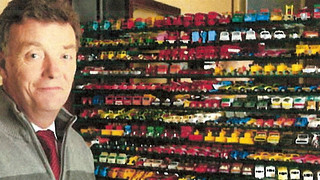 Sixty-eight-year-old Simon Hope's Matchbox collection was so massive that he had to use three different auctions to clear the whole lot. Hope amassed almost 3,000 of
the tiny toys, and all told, the auctions pulled in nearly $400,000. The most expensive vehicle almost hit the $10,000 mark.
Sixty-eight-year-old Simon Hope's Matchbox collection was so massive that he had to use three different auctions to clear the whole lot. Hope amassed almost 3,000 of
the tiny toys, and all told, the auctions pulled in nearly $400,000. The most expensive vehicle almost hit the $10,000 mark.
Hope is the founder and Chief Auctioneer at H&H Classics in the United Kingdom. There, he's been running the show for approximately 30 years and has dealt with a variety of items such as classic cars, motorcycles, aircrafts, carpets, and other antiques. His first classic car was a 1947 Sunbeam Talbot Ten in high school, and he has owned a De Dion Bouton, Rolls-Royce, Bentley, Riley, Cadillac, Jaguars, Aston Martins, Maseratis, Ferraris, Lotuses and a Mille Miglia Allard J2 since.
Before (and after) the Talbot, his passion for motor vehicles was stored in small rectangular cardboard boxes. In a note written by Hope himself, he says his parents started buying them for him at age 2. The passion infiltrated his imagination, but he was not one to drive them on the wall in the bath or down the driveway outside.
"I simply opened the box, took the model out, looked it all over, ran it a couple of times along the table or floor, and promptly put it back in the box," the note details. "It didn’t help when Gran simply refused to let me play with them at all when we went to see her. It then got put on a shelf in my bedroom and waited until the next birthday etc for another friend to join it on the shelf. This continued until I started to earn pocket money or ‘paper round’ money, and it all went on models (well maybe the odd sweet) and most of those models are included in this sale."
Because of this, the collectibles are in incredible condition and still in the original packaging. Although some of the cars in the collection are extremely rare and desired, Hope points out he was never chasing. If he saw something that sparked joy, he bought it.
To read the complete article, see:
A nearly 3,000-piece Matchbox collection sold for almost $400,000
(https://www.autoblog.com/2020/01/10/matchbox-car-collection-sells-for-400000/)
Large Denomination U.S. Paper Money
Howard Daniel forwarded this MSN article featuring images of large denomination U.S. paper money. Thanks. -Editor
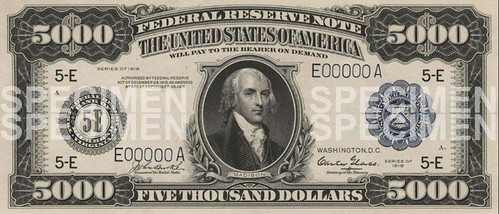
To read the complete article, see:
Pictures of big bills: You
probably won't see them in circulation, but you can see them here
(https://www.msn.com/en-us/money/markets/pictures-of-big-bills-you-probably-wont-see-them-in-circulation-but-you-can-see-them-here/ss-BBQdo55)
BATHROOM FLOOR TILED WITH PENNIES
It's been done before, but it's still a pretty cool idea, whether you're a coin collector or not. Here's a story from England about a man who tiled his bathroom floor with 5,500 one penny coins. -Editor
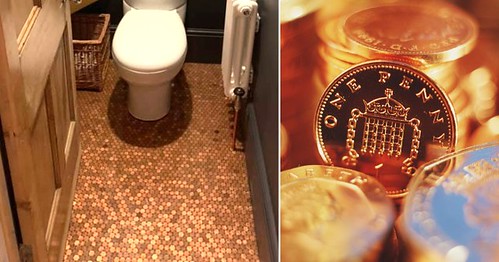
Heard of the saying spend a penny?
Well, one man is taking it quite literally, by recovering his entire bathroom floor in pennies.
His daughter posted the image in the DIY On A Budget Official Facebook group and the idea was a hit.
She said that the floor contains £55 worth (so 5500 pennies). Her dad stuck them all down with glue and then pour epoxy resin over the top to make it level, protect it from water and to stop the pennies being tarnished.
It took around a day to dry but luckily he has another loo in his house he could use while it set.
To read the complete article, see:
Man creates new bathroom floor by tiling £55 worth of 1p coins
(https://metro.co.uk/2020/01/05/man-creates-new-bathroom-floor-tiling-55-worth-1p-coins-12003725/)

